The RWA industry is transitioning from a technology-driven "first half" to a "second half" defined by institutional demand and regulatory compliance.
Author: Pharos Research
Abstract
The tokenization of Real World Assets (RWA) has become the core narrative of this crypto cycle, aiming to bring trillions of dollars of traditional financial assets on-chain and build the next generation of financial infrastructure that connects the real economy with decentralized finance (DeFi). Despite the enormous market potential (Boston Consulting Group predicts it could reach $16 trillion by 2030), its development still faces three structural bottlenecks: regulatory compliance, asset mapping, and secondary market liquidity.
As of the end of August 2025, the global non-stablecoin RWA market size is approximately $28 billion, a year-on-year increase of 114%. The market structure is dominated by debt-like assets, with private credit holding an absolute leading position at $16 billion (about 56%), followed by U.S. Treasury bonds ($7.5 billion) and commodities ($2.4 billion). Ethereum is currently the main network for RWA.
This report provides an in-depth analysis of three core tracks:
• Private Credit: As the largest segment of RWA by volume, its core value lies in enhancing the efficiency and transparency of traditional credit processes, but pre-loan review, risk control, and default management still heavily rely on off-chain legal frameworks. The market is transitioning from early exploration to a stage of institutional diversification represented by Maple and Figure.
• Commodities: The market is monopolized by the dual oligopoly of gold tokens PAXG and XAUT, which account for over 75% of the market share. Liquidity in this segment is mainly concentrated in centralized exchanges, with low integration into the DeFi ecosystem. Future growth points lie in the diversification of issuers and underlying assets (such as precious metals other than gold and silver, and agricultural products).
• Stocks: This segment is still in its very early stages, with a total market capitalization of about $360 million, which is negligible compared to traditional stock markets, and severely lacking in liquidity but with enormous growth potential. The market is evolving along two paths: one represented by Robinhood, which sacrifices composability for a highly compliant "walled garden" model; the other represented by xStocks, aiming for deep integration with DeFi as an "open financial bridge." The entry of giants like Ondo Finance, which holds a full set of compliance licenses, indicates that competition in this segment will become increasingly fierce.
Conclusion: The RWA industry is moving from a technology-driven "first half" to a "second half" defined by institutional demand and regulatory compliance. Its long-term value lies not in short-term speculation, but in the robust growth of on-chain asset scale, effective deepening of secondary market liquidity, and the solid improvement of legal and technical frameworks. RWA will create the next generation of financial infrastructure that connects real value with the on-chain world, strongly promoting the construction of a more transparent, efficient, and inclusive global financial model.
Keywords: RWA; Tokenization; Regulatory Compliance; Financial Infrastructure
01 Introduction
As the crypto market bids farewell to the illusory returns of high leverage and seeks a sustainable growth path deeply tied to the real economy, the tokenization of Real World Assets (RWA) has become the most imaginative core narrative of this cycle. It not only opens up vast channels for the on-chain world to draw value from the real world but also provides a digital migration path to higher efficiency and stronger liquidity for the massive stock of traditional financial assets worth trillions of dollars. RWA is essentially a key "connector" for building the next generation of financial markets, and its maturity will directly determine whether blockchain technology can transition from a closed crypto-native loop to a broad future integrated with the global economy.
Despite institutions like the Boston Consulting Group (BCG) predicting a potential market space exceeding $10 trillion, the path of "asset on-chain" is not without challenges. From grand visions to real business practices, RWA must overcome three structural mountains: regulatory compliance, asset mapping, and market liquidity. How can we ensure the legal effectiveness of on-chain certificates and off-chain rights are unified? How can we create effective secondary market liquidity while maintaining compliance? These are fundamental challenges that practitioners are striving to overcome.
To comprehensively present this complex and dynamic field, this report will systematically discuss from macro to micro. It will first outline the industry panorama of RWA, including its market size, growth drivers, and core bottlenecks; then, it will focus on the three core tracks currently developing most rapidly—private credit, commodities, and stocks—providing an in-depth analysis of the market structure, operational models, and leading players in each track. Through this report, we aim to provide readers with a clear blueprint of the current landscape, future trends, and potential opportunities of RWA.
02 Industry Overview and Trend Analysis
2.1 Definition of RWA
Real World Assets (RWA) refer to various types of assets that exist off-chain and have economic value, transformed into on-chain tradable digital certificates through issuance, mapping, pledging, or splitting. The core logic is to leverage smart contracts and open financial protocols to achieve efficient utilization, transparent operation, and flexible combination of assets on the blockchain.
Currently, the coverage of RWA is quite broad, encompassing almost all major categories of traditional finance and physical assets. From government and corporate bonds to commodities, real estate, equity securities, and even artworks and intellectual property, all can achieve rights confirmation, segmentation, and trading through on-chaining.
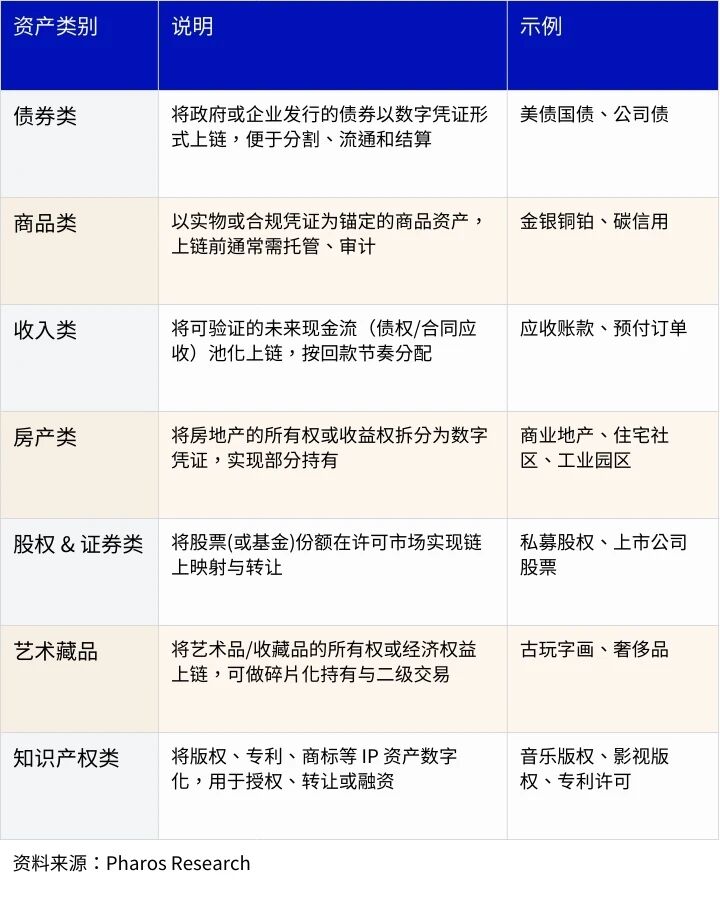
The advantages of on-chaining RWA mainly lie in three aspects: liquidity, transparency, and cost efficiency. On one hand, on-chaining can enhance the global circulation and settlement efficiency of assets while significantly reducing costs associated with intermediaries; on the other hand, the traceability of blockchain and the mechanism of smart contracts make asset transactions and management more open and transparent. Additionally, once RWA enters the chain, it can further integrate deeply with the DeFi ecosystem, creating new use cases and revenue models, thus giving rise to the concept of "RWAfi."
It is noteworthy that some RWA products have already achieved breakthrough applications, providing investors access to asset classes that are difficult to reach directly in traditional markets. For example, Goldfinch's Private Debt FoF product has underlying allocations in private debt assets from large funds like Ares. In the traditional financial system, such products have extremely high investment thresholds, while on the Goldfinch platform, investors can participate with just $100. Similarly, products like USDY, which are based on U.S. Treasury bonds, effectively solve the problem of compliance restrictions that make it difficult for investors from certain countries to purchase U.S. bonds directly.
2.2 Market Size and Growth Potential
2.2.1 Market Size
As of the end of August 2025, the total size of the global on-chain non-stablecoin RWA market is approximately $28 billion, with a year-on-year growth rate of nearly 114%, and a compound annual growth rate (CAGR) of about 111% over the past three years. Among them, debt-like RWAs represented by U.S. Treasury bonds and private credit are the main driving forces, with three-year CAGRs reaching 1,523% and 104%, respectively.
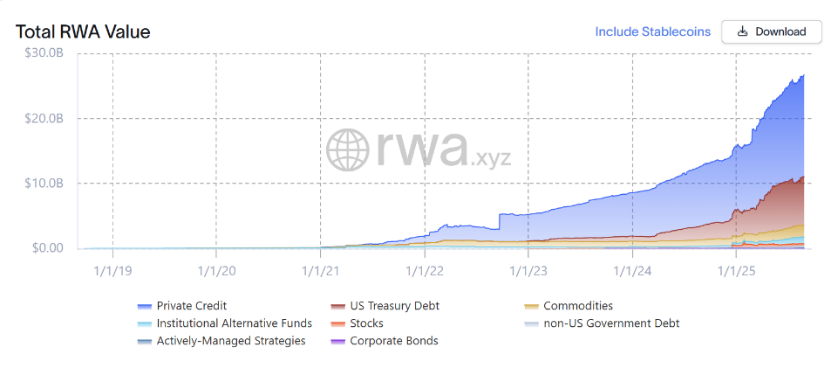
Source: Pharos Research, RWA.xyz
In terms of on-chain distribution, Ethereum remains the core platform for RWA, accounting for about 53.3% of the market share, with a managed scale of $8.31 billion; ZKsync Era ranks second, with a market share of 15.4% and a scale of about $2.4 billion.

Note: There is a discrepancy in the statistical caliber of data regarding "commodities" on the RWA.xyz platform; another figure is $1.9 billion, but after verification, the $2.36 billion figure was chosen.
Analyzing by asset category: the top three segments of on-chain RWA are Private Credit, US Treasury Debt, and Commodities, with current sizes of $16 billion, $7.5 billion, and $2.4 billion, respectively, accounting for approximately 56%, 27%, and 9%. Private Credit mainly connects to high-yield assets such as corporate credit, accounts receivable, and structured debt, with representative platforms including Figure Protocols, Centrifuge, Maple, and TrueFi; the typical product in the U.S. Treasury bond segment is BUIDL (size $2.39 billion), with underlying assets covering short-term government bonds and reverse repos; the commodities segment is mainly contributed by PAXG and XAUT, which together account for 75% of the gold tokenization market size.
Note: The above data is sourced from RWA.xyz and organized by Pharos Research.
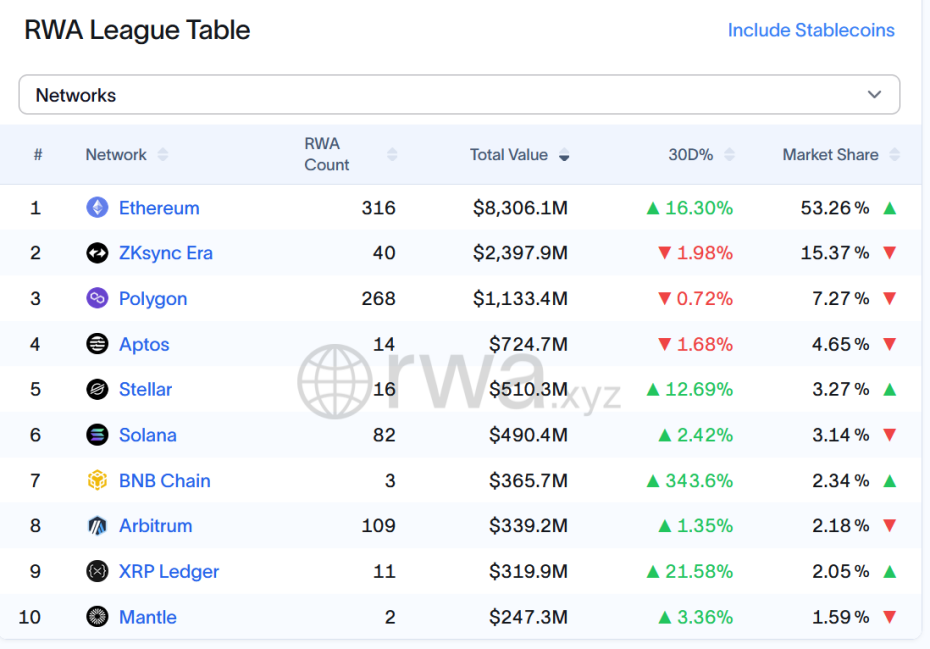
Source: Pharos Research, RWA.xyz
2.2.2 Growth Potential
Looking ahead, the market generally believes that the expansion space for RWA has not yet reached its limit. According to a joint research report titled "Relevance of On-Chain Asset Tokenization in ‘Crypto Winter’" published by Boston Consulting Group (BCG) and digital securities platform ADDX in July 2022, the total size of global tokenized assets is expected to reach $16 trillion by 2030, representing over 600 times the current level of growth potential.
An important reference point is the development of crypto asset ETFs. As of the close on August 27, 2025, the total size of Bitcoin ETFs is $144.6 billion, and Ethereum ETFs is $32.6 billion, totaling about 6.6 times the non-stablecoin RWA market. From a structural logic perspective, there are significant differences in their positioning in the capital market: ETFs serve more as "funding entrances," packaging on-chain crypto assets into traditional financial products to facilitate traditional capital entering the market; while RWA plays the role of "asset export," mapping off-chain real assets on-chain to build a new market foundation for the DeFi ecosystem.
On the other hand, the significance of ETFs lies in the establishment of compliant channels and recognition at the public offering level, but their investment targets remain limited to BTC and ETH, primarily satisfying speculative and hedging needs. In contrast, the advantage of RWA lies in the breadth of asset coverage and the support of real returns. Bonds, gold, real estate, corporate credit, and more can all become underlying configurations of on-chain assets, allowing DeFi protocols to carry richer real-world value. In comparison, ETFs essentially represent a repackaging of existing crypto assets, while RWA is more likely to achieve a deep structural integration with traditional finance. Through smart contracts and on-chain account systems, RWA can be embedded in various DeFi applications such as collateralized lending, yield aggregation, and stablecoin anchoring, driving the formation of a new financial market landscape.
Therefore, in terms of scale potential, the development of ETFs is more oriented towards inflows of hundreds of billions of dollars, while the upper limit of RWA corresponds to over $100 trillion in global investable financial assets. The former is closer to the derivatives level of traditional markets, while the latter directly targets the underlying asset access of primary and secondary markets. The development path of RWA is more complex, but its long-term significance and depth of ecological embedding clearly far exceed that of ETFs.
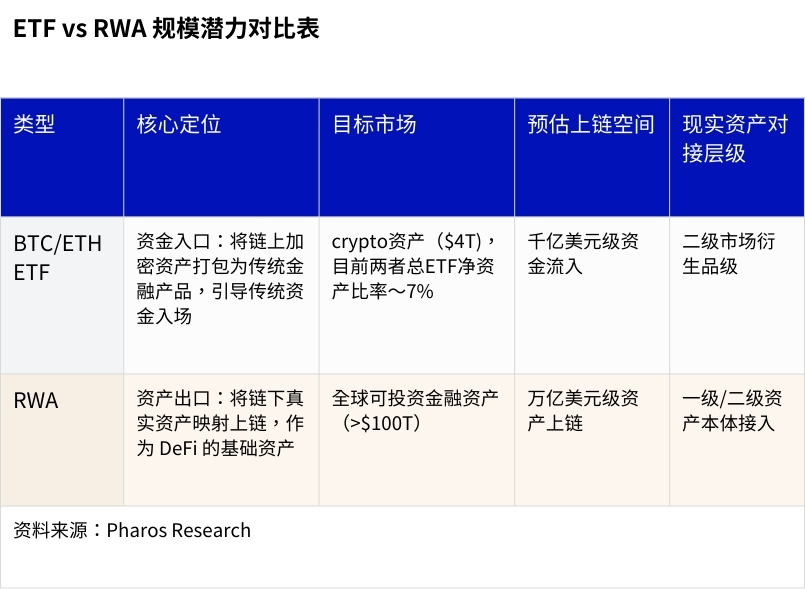
2.3 Industry Driving Factors
The forces supporting the continued increase in RWA penetration are primarily reflected in three main lines: the interest rate cycle, institutional entry, and regulatory progress.
2.3.1 Rising Interest Rate Cycle: Real Interest Becomes the Anchor for On-Chain Allocation
Since 2022, the world has entered a high-interest-rate environment, especially with the U.S. federal benchmark interest rate remaining above 5%, significantly enhancing the attractiveness of traditional assets like U.S. Treasury bonds and money market funds. At the same time, as the crypto market experiences deleveraging and a decline in risk appetite during the transition between bull and bear markets, issues such as the decline of risk-free rates in traditional DeFi and the homogenization of yield strategies have become prominent, accelerating investors' demand for "stable, predictable" yield-bearing targets. The positioning of RWA aligns perfectly here: by mapping U.S. Treasury bonds, bonds, and various verifiable income certificates on-chain, it provides on-chain funds with an alternative allocation of "low volatility + real interest," re-establishing the connection between on-chain yields and off-chain interest rate centers.
2.3.2 Leading Institutions Driving: Asset Supply and Credit Endorsement Synchronized On-Chain
Since 2023, global financial giants such as BlackRock, Franklin Templeton, WisdomTree, JPMorgan, and Citibank have successively entered the RWA space, covering paths such as on-chain fund share issuance, tokenized U.S. Treasury products, and Tokenized Asset funds, attempting to achieve "native on-chaining" of underlying assets rather than simple bridging. Thus, one end is based on the credit of sovereign and financial institutions, while the other end uses on-chain clearing and settlement and composability as a carrier, significantly enhancing the market's acceptance and sustainability of RWA through the combination of trust and efficiency. Representative practices include: Franklin Templeton issuing U.S. money market fund shares BENJI Token on Polygon and Stellar; BlackRock investing in Securitize and planning to issue tokenized funds on Ethereum; Citibank promoting on-chain settlement pilots for certain custodial bonds. These initiatives collectively expand the on-chain supply of compliant assets and strengthen market expectations through the participation of large institutions.
2.3.3 Formation of Regulatory Framework: Marginal Opening of Compliant Channels
Unlike the rough expansion during the ICO era, RWA corresponds primarily to heavily regulated assets such as securities, bonds, and funds, which must be advanced within existing legal and licensing frameworks. In the past two years, regulators in various regions have gradually clarified the legal basis for asset on-chaining, token issuance, and holder rights, providing institutional guarantees for project pilots and scaling.
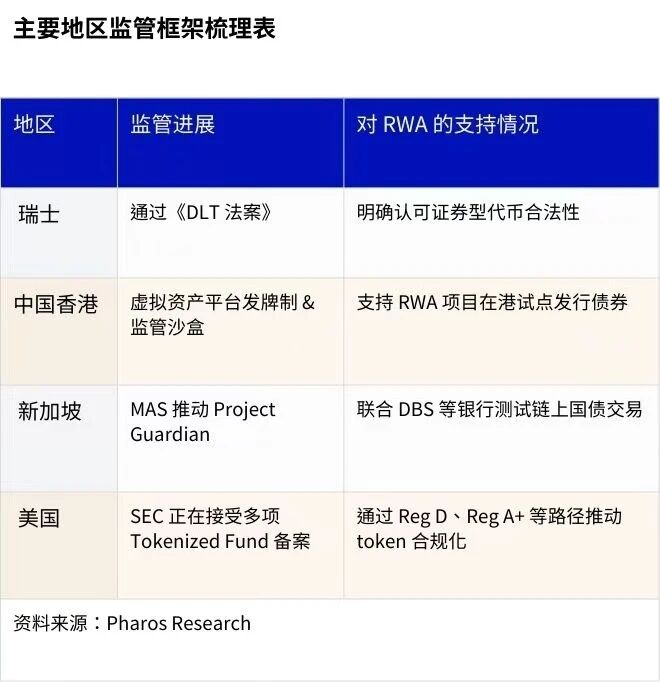
Note: Reg A+ is a "lightly regulated" public offering mechanism under U.S. securities law, allowing issuers to offer stocks or tokens to ordinary investors under non-IPO conditions, with an annual fundraising cap of $75 million. Exodus Movement, INX, and tZERO have all completed asset issuance based on this.
In terms of specific implementations, Switzerland's Sygnum Bank has issued tokenized bonds, allowing investors to participate in corporate financing on-chain; Hong Kong also supports the issuance of HKD 200 million tokenized green bonds by China Construction Bank, regarded as one of the first government-supported Tokenized Bond projects in Asia. These explorations indicate that, under the premise of legal certainty and clarity of holder rights, the productization and scaling of RWA have replicable paths.
2.4 Major Players in the Industry
Surrounding the entire chain of "assets—issuance—trading—data," the RWA ecosystem can generally be divided into four types of entities: asset issuers, infrastructure providers, application layer platforms, and data service providers. Each role collaborates in compliance, custody, clearing and settlement, and user engagement.
2.4.1 Asset Issuers (Token Issuers)
Asset issuers are positioned to convert real assets (such as U.S. Treasury bonds, gold, real estate, etc.) into tradable certificates on-chain, undertaking core responsibilities such as compliance structure design, yield distribution, and custody supervision.
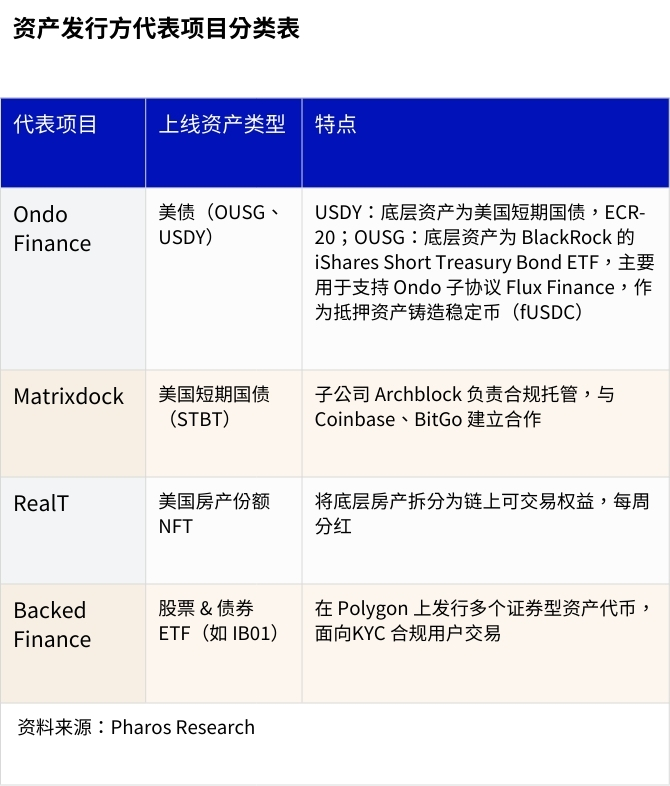
2.4.2 Infrastructure Providers (RWA Infra & Issuance Chains)
Infrastructure providers offer underlying capabilities such as issuance, identity verification, compliance support, and asset custody, often found in dedicated public chains, permissioned chains, or compliant issuance platforms.

2.4.3 Application Layer Platforms (Access Products & User Protocols)
Application layer platforms provide users with entry points for investment and portfolio management, often coupled with DeFi modules, connecting retail investors with on-chain RWA.
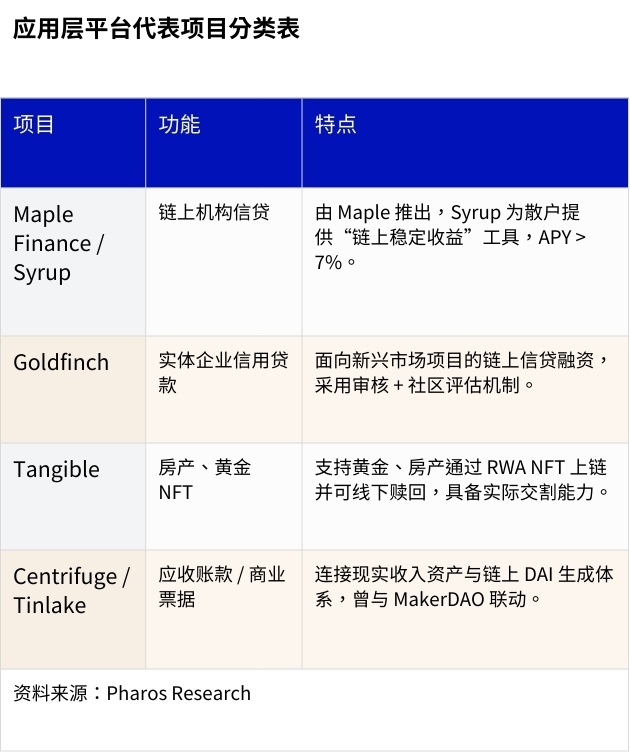
2.4.4 Data and Index Service Providers (Oracles & Indices)
Data and index service providers supply data such as prices, indices, and reference rates to on-chain protocols, serving as a bridge between off-chain information and on-chain contracts.

2.5 Industry Bottlenecks
In the short term, the scaling of RWA is not driven by a single technological bottleneck but is constrained by a set of profound structural constraints. These constraints are primarily reflected in the dynamic evolution of business forms, the inherent limitations of market liquidity, and the fundamental challenges of compliance frameworks and asset mapping, ultimately shaping the current unique audience structure and market landscape.
2.5.1 Dynamic Evolution of Business Models: High Project Maturity and Information Verification Costs
Currently, most projects in the RWA space are still in the exploration and experimentation stage of their business models, with frequent switches in core products and strategic positioning, leading to significant time lags and content discrepancies between publicly available information and actual project operations. A typical phenomenon is that public materials or press releases from months ago can no longer accurately reflect their current business focus, such as the project Credix, which has shifted from an early narrative of a credit platform to a PayFi product matrix. This high-frequency business iteration undoubtedly brings extremely high information verification costs and assessment difficulties for external institutions conducting due diligence and ongoing tracking.
2.5.2 Structural Bottlenecks of Market Liquidity: Access-Based Trading Remains the Market Mainstream
From a trading structure perspective, the liquidity of the vast majority of current RWA products is strictly limited. Whether it is the LP certificates of private credit or mainstream tokenized Treasury products, their trading and transfer are generally restricted to whitelisted addresses. Asset categories that can achieve permissionless and free circulation in the secondary market remain few, mainly concentrated in two categories: (1) underlying assets that are highly standardized commodities (such as gold); (2) U.S. Treasury products with broader circulation issued by institutions like Ondo Finance under specific compliance frameworks (such as $USDY). This access-based market structure significantly suppresses effective price discovery of assets and the exit efficiency of holders.
2.5.3 Fundamental Challenges of Compliance and Asset Mapping: Cross-Domain Governance Gaps Await Bridging
The core of RWA lies in constructing a reliable mapping between on-chain digital certificates and off-chain legal rights and physical assets. Current mainstream solutions often adopt a "hybrid architecture," completing compliance reviews (KYC/AML) off-chain through SPVs or regulated custodians, and then issuing standardized tokens (such as bTokens) for circulation on-chain. However, against the backdrop of varying regulatory policies across different jurisdictions and the absence of on-chain identity systems, the sustainability of this model is concerning, specifically with the following issues:
• Regulatory Arbitrage and Policy Risks: A considerable number of projects have not obtained securities issuance licenses in their respective jurisdictions but instead evade the legal definition of "securities" through clever structural designs. This operation in a regulatory gray area exposes them to the risk of policy tightening, and once the regulatory environment changes, they may face compliance crises leading to business withdrawal.
• Vulnerability of Asset Verification and Rights Protection: Whether there is a precise and reliable correspondence between on-chain tokens and off-chain real assets is a core concern for investors. Currently, users mostly rely on audit reports or asset proofs issued unilaterally by project parties or custodians, which lack unified standards and legal enforceability. More importantly, when extreme situations such as defaults, early redemptions, or SPV bankruptcies occur with the underlying assets, the rights claims and liquidation recovery processes for on-chain token holders are highly opaque, and smart contracts themselves cannot automatically handle complex off-chain legal procedures. The previous incident with Maple Finance, where LPs were unable to redeem due to defaults by some borrowers, is a typical example that ultimately required returning to off-chain legal avenues for resolution.
• Legal Dilemmas of DeFi Integration: Integrating RWA as collateral into DeFi lending or automated market maker (AMM) protocols is an important direction for enhancing its application value, but it also brings new legal identity definition challenges. The current legal framework does not clearly define the properties of such integrated products, potentially exposing both project parties and users to accusations of "illegal securities issuance" or "cross-border trading violations."
The above issues have led to a fundamental adjustment in the grand narrative of "asset mapping," significantly increasing uncertainty regarding compliance and regulation. In specific market cases, there have been responses to this; for instance, Backed Finance has proactively chosen to limit trading to whitelisted addresses to ensure compliance, sacrificing the potential liquidity of the assets. The on-chain property tokens from RealT still heavily rely on the KYC verification mechanisms of U.S. entities for the ultimate realization of their value.
In summary, considering the above constraints, the current market positioning of RWA shows a "layered effect." On one hand, traditional institutions maintain a highly cautious attitude towards the operational risks and compliance uncertainties of on-chain activities; on the other hand, crypto-native users (Crypto Degen) pursuing high volatility and short-term returns find the yields of RWA unattractive. Therefore, the core target audience for RWA currently mainly falls on traditional financial retail investors (TradFi Retail) seeking robust asset allocation and large on-chain fund holders (Whales)—regionally, this demand is particularly pronounced in countries with high inflation globally (such as Latin America and Southeast Asia).
03 Core Track Analysis: Private Credit
3.1 Market Overview
Among the various forms of RWA (excluding stablecoins), private credit has consistently ranked at the forefront in terms of volume and proportion. With $16.0B in Active Outstanding Loans (the balance of loans that have been issued but not yet repaid), it accounts for approximately 56% of this track.

Source: Pharos Research, RWA.xyz
As a key branch of private finance, the private credit market has developed into a mature asset class since its inception by giants like Blackstone and KKR in the 1980s and 1990s. Especially after the 2008 financial crisis, as traditional commercial banks tightened their credit policies, private credit quickly filled the market gap, becoming an important financing channel for small and medium-sized enterprises (SMEs). By 2023, its global market size has exceeded $1.6 trillion. This type of asset primarily targets SMEs that find it difficult to obtain financing from public markets or banks for various reasons, providing non-publicly traded loans.
The operational structure of private credit can be clearly divided into two levels: off-chain and on-chain. Off-chain, the source of the assets remains real and legally binding loan contracts, which are typically held and managed by a special purpose vehicle (SPV); on-chain, the protocol encapsulates the claims held by the SPV into standardized digital tokens using technical standards such as ERC-20 or NFT.
The core characteristics of private credit are reflected in several aspects: first, the investment threshold is relatively high, with participants typically being qualified investors such as family offices and professional private equity funds, aiming for high fixed returns. Second, asset liquidity is inherently limited; due to low transparency, it is often viewed as a "black box," and the loan terms are relatively long, making early exit from investments difficult. Nevertheless, private credit features a standardized fixed income structure, with clear interest rates, repayment plans, and maturity dates, and increasingly aligns with institutional standards in terms of disclosure and auditing, relying on SPVs and KYC compliance frameworks. Common underlying assets include SME loans, invoice and accounts receivable financing, trade financing, consumer loans, and real estate mortgages.
3.2 Value and Limitations of Tokenization Models
The core value of on-chain private credit lies in reshaping and optimizing traditional business processes through blockchain technology. It directly connects capital providers with borrowers through protocols and utilizes smart contracts to transform previously manual processes such as asset custody, fund transfers, repayment management, and interest distribution into automated processes that are visualized and traceable on-chain. For investors, this model simplifies their investment behavior to token subscription, with the tokens directly representing clear rights to the underlying loan principal and interest. Ultimately, the efficiency and transparency of the entire asset handling process are significantly enhanced.
It is important to emphasize that tokenization does not change the off-chain attributes and dependencies of the asset. Borrowers, pre-loan reviews, collateral management, repayment, and default handling all occur in the off-chain world; on-chain primarily serves as a layer for digital certificates and settlement. Therefore, if there is a default off-chain, the on-chain tokens cannot automatically exercise rights and still need to rely on traditional legal and compliance frameworks for resolution. Thus, the SPV essentially acts as an off-chain compliance intermediary, meaning that investors do not directly hold the loan assets but rather hold the claims indirectly through the SPV, with its registration, operation, auditing, and default processes all falling within the off-chain legal system. Borrower access, KYC, credit assessment, and risk control are also managed by centralized entities, making it difficult to operate in an open matching manner like algorithmic models such as Aave.
3.3 Major Players
Since its rise in 2021, the total issuance scale of on-chain private credit (including repaid portions) has exceeded $29 billion, with over 2,500 loan projects issued cumulatively, and the current average annualized return rate (APR) in the market is 9.75%. The market landscape is gradually becoming clearer, with a number of leading participants standing out due to their stable operations and high total value locked (TVL), including Maple, Goldfinch, Figure, Centrifuge, PACT, and Tradable.
3.3.1 Maple: A Robust Institutional-Level On-Chain Credit Market
Project official website:
https://maple.finance/
Project official X account:
https://x.com/maplefinance
Maple Finance is positioned as an institutional-level credit platform, initially focusing on unsecured loan business. After experiencing the Orthogonal Trading default incident, the platform's strategic focus has shifted to a more robust over-collateralization (requiring a 150% collateralization rate) and tri-party agreement model. In this model, an independent third-party institution is responsible for monitoring the value of the collateral, while Maple focuses on executing smart contracts. If the collateral value falls below a preset threshold and the borrower fails to supplement the collateral within 24 hours of receiving a margin call, a third party will trigger liquidation to protect the interests of the lender. As of the end of August 2025, Maple Finance's assets under management exceeded $3.3 billion, with a cumulative lending total exceeding $8.9 billion.
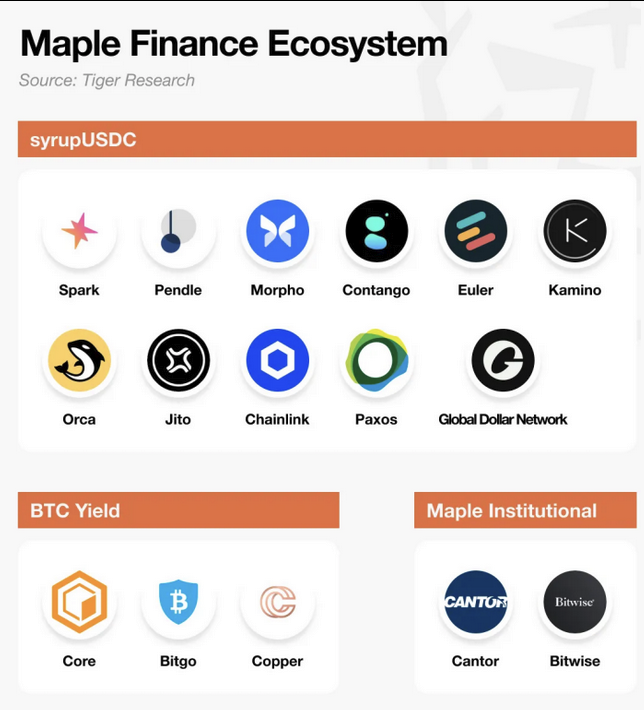
Source: Pharos Research, Maple Finance, Tiger Research

Source: Pharos Research, Maple Finance
The platform's core product lines are divided into "Permissioned Access" and "Open Access" to meet the needs of institutional and retail investors, respectively.
The "Permissioned Access" product series is designed specifically for institutional clients, featuring KYC certification and a minimum investment threshold of $100,000, providing a private banking-like 24/7 "white glove" service, offering one-on-one support for solution design, fund management, and problem resolution. This series includes three products:
• Blue Chip Lending Pool: Targeting conservative risk preference investors, it only accepts mature crypto assets such as Bitcoin and Ethereum as collateral, investing in high credit-rated loan projects, providing an annualized return of about 6.5%.
• High Yield Lending Pool: Aimed at investors seeking higher returns and able to bear corresponding risks, its core strategy is to amplify returns through asset pledging or secondary lending rather than passive holding of collateral, with an annualized return of up to 10.4%.
• Bitcoin Yield Product: This product aligns with the growing trend of institutional demand for Bitcoin allocation, utilizing the dual staking mechanism provided by Core DAO. Institutional clients can custody their Bitcoin with institutional custodians like BitGo or Copper, earning 4-6% staking returns by committing not to sell the assets during the lock-up period.
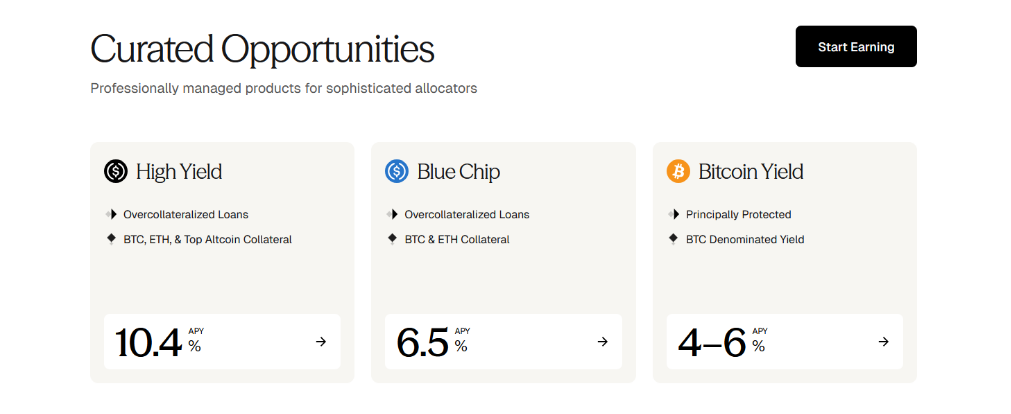
Source: Pharos Research, Maple Finance
To allow ordinary retail investors to participate, Maple Finance launched the Syrup series of liquidity certificates (LP Token) in the second half of 2024. As of the end of August 2025, the total value locked (TVL) of SyrupUSDC exceeded $2.2 billion, while SyrupUSDT exceeded $152 million, both providing an annualized return of about 6.9%. The funds raised through Syrup will be lent to institutional borrowers from the platform's blue chip and high yield pools, with the interest generated from the loans directly distributed to Syrup depositors. Although this product shares a similar underlying asset structure with institutional pools, its risks are independently isolated.
While the direct yield of Syrup is slightly lower than that of institutional products, Maple has introduced the "Drips" reward system to incentivize long-term participation. This system calculates additional rewards in points every four hours and allows users to exchange points for the platform's governance token SYRUP at the end of each quarter. Staking SYRUP itself can earn an annualized return of 2.98%, and the platform allocates 20% of the revenue from lending service fees (ranging from 0.5% to 2%) for repurchase in the open market and distribution to SYRUP stakers.
Additionally, to enhance the liquidity and composability of its assets, SyrupUSDC has been integrated into several leading DeFi protocols, such as:
• Spark: As a sub-DAO of the Sky ecosystem, Spark has injected $300 million into the SyrupUSDC pool to provide yield sources for its stablecoin.
• Pendle: Users can trade the principal and yield portions of SyrupUSDC (PT-SyrupUSDC and YT-SyrupUSDC) on the Pendle platform and receive a 3x Drips reward bonus.
• Morpho / Kamino: In these lending protocols, SyrupUSDC and its derivatives can be used as eligible collateral for borrowing other assets such as USDT or USDC.
3.3.2 Goldfinch: On-Chain Unsecured Credit Protocol Focused on Emerging Markets
Project official website:
https://www.goldfinch.finance/
Project official X account:
https://x.com/goldfinch_fi
In the field of on-chain private credit, Goldfinch has garnered attention for its unique market positioning focused on "unsecured credit." The core business model of the protocol is to provide financing to fintech companies and lending institutions in emerging markets, with borrowers widely distributed across Latin America, Southeast Asia, and Africa. The underlying assets of these loans primarily consist of consumer credit, education loans, and financing for micro and small enterprises, such as funding support for India's electric vehicle company Greenway and Nigeria's consumer loan platform QuickCheck. To date, Goldfinch has facilitated the issuance of over $160 million in loans.[7]
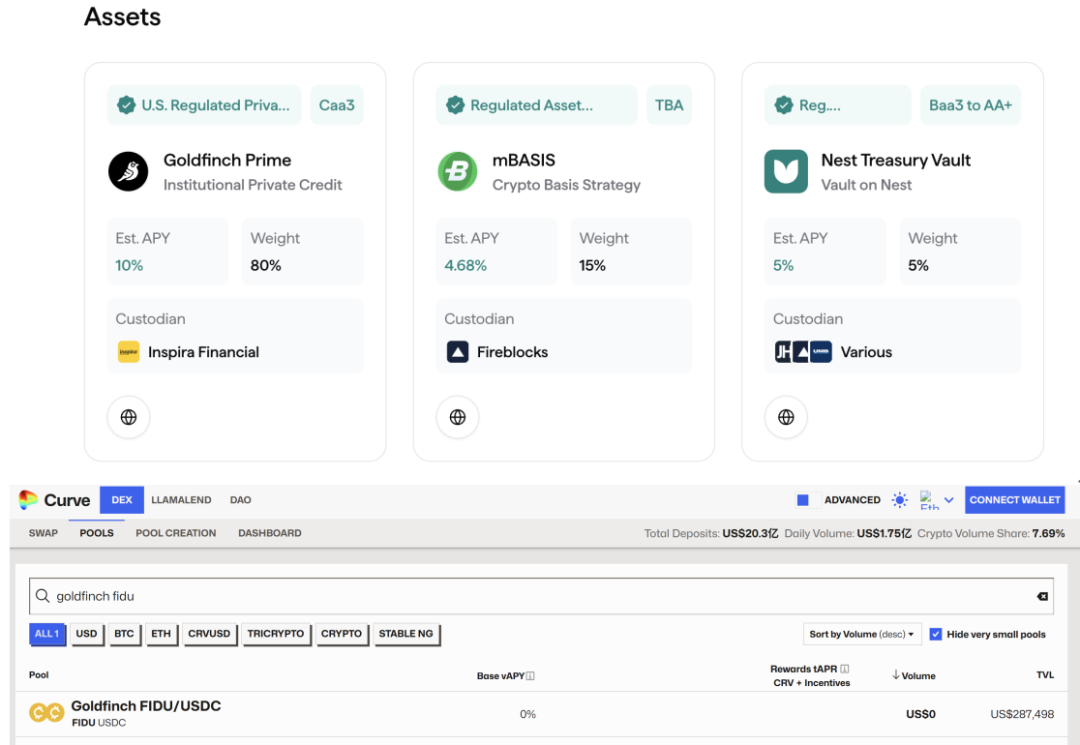
Source: Pharos Research, Goldfinch Finance, Curve
The protocol's structural design revolves around a main funding pool (Senior Pool) and multiple independent borrower sub-pools (Borrower Pool). In a typical loan transaction, the main funding pool provides about 90% of the funds, which are automatically allocated by the protocol's smart contracts. The remaining portion is provided by "Backers," whose role is similar to that of subordinated investors in traditional finance, and is only open to qualified investors. Ordinary investors act as liquidity providers (LPs) and can obtain FIDU tokens by depositing USDC into the main pool. FIDU not only represents their share of the debt in all loan projects but also provides investors with interest paid monthly or quarterly. This investment channel is open to retail investors outside the U.S. and qualified investors within the U.S., with a minimum investment threshold of $100. Although FIDU tokens can theoretically earn additional GFI token incentives in the liquidity pool on the Curve platform, their secondary market liquidity is currently very limited.
Additionally, to expand its institutional business, Goldfinch has launched a private credit asset pool called Goldfinch Prime. This product packages assets from top private equity funds such as Apollo, Ares, Golub, and KKR onto the blockchain and allows retail users to deposit USDC to earn an annualized return of about 7% through the Nest Vault supported by Plume. However, this funding pool has a 10-day redemption lock-up period, and its current total assets under management (TVL) of $440,000 is relatively small.
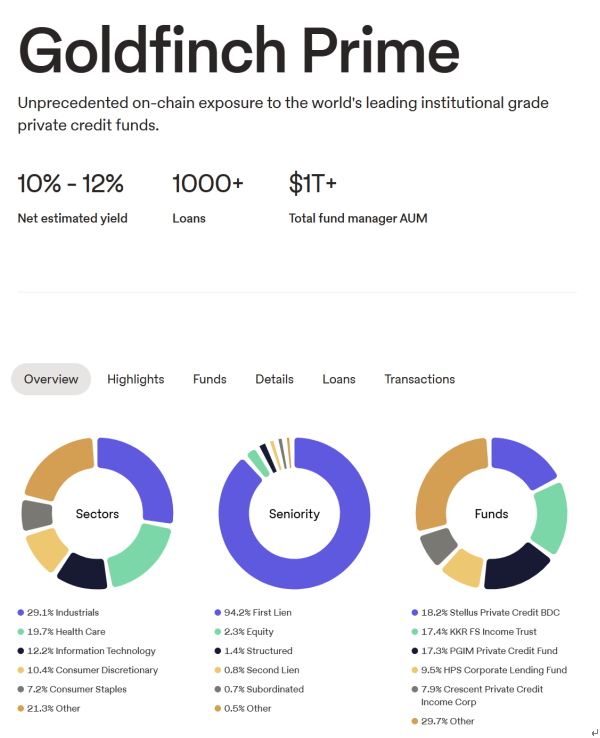
Source: Pharos Research, Goldfinch Finance
3.3.3 Figure: Institutional-Level Credit Ecosystem Built on a Compliant Permissioned Chain
Project official website:
https://www.figure.com/
Project official X account:
https://x.com/Figure
As a representative force in the U.S. private credit RWA ecosystem, Figure has become one of the largest entities in terms of on-chain loan issuance scale. Its business scope is broad, covering various categories such as home equity loans (HELOC), refinancing loans, and consumer credit, with a cumulative loan issuance scale exceeding $16 billion[5]. Unlike Goldfinch, Figure's underlying assets are primarily secured loans, using real-world properties or qualified credit as collateral for lending.
Figure's core operational mechanism relies on its self-developed Provenance blockchain. The protocol establishes special purpose vehicles (SPVs) to hold and manage off-chain loan assets and issues corresponding tokenized securities on the Provenance chain. These tokens are not open to the public but are specifically available for subscription by institutions such as funds and asset management companies. The asset redemption and income distribution follow strict off-chain compliance processes to ensure the legality of the entire process.
Figure's ecosystem exhibits a highly closed characteristic. Provenance is a permissioned blockchain built on the Cosmos SDK, where the operation of validator nodes, deployment of smart contracts, and circulation of assets all require strict whitelisting and compliance reviews. This feature currently prevents RWA assets within the Figure ecosystem from being freely combined with the broader DeFi system and has not provided direct on-chain investment access for retail investors. Thanks to its compliance framework, Figure has established deep cooperative relationships with several traditional financial giants, including Franklin Templeton, Apollo Global Management, Jefferies, and Hamilton Lane. The market expects that these institutions may utilize the Provenance blockchain to issue their own tokenized private credit products in the future.
3.3.4 Centrifuge: Strategic Evolution from Market Pioneer to Compliance Infrastructure
Project official website:
https://centrifuge.io/
Project official X account:
https://x.com/centrifuge
As an early explorer in the field of on-chain private credit RWA, Centrifuge successfully issued multiple real-world asset-backed funding pools through its Tinlake framework, covering diversified assets such as real estate mortgages (New Silver), logistics receivables (ConsolFreight), and microloans (Branch). These asset pools are isolated through independent SPVs and innovatively adopt a layered structure, issuing DROP tokens representing priority and stable returns and TIN tokens representing subordinated, high-risk, high-return investments. This model achieved significant success between 2021 and 2023 and once became a benchmark project for minting DAI through real collateralized debt within the MakerDAO protocol. Currently, this structure has completed its historical mission, and the Tinlake front end has been integrated into the new Centrifuge App, with related asset pools entering the repayment and exit phase.
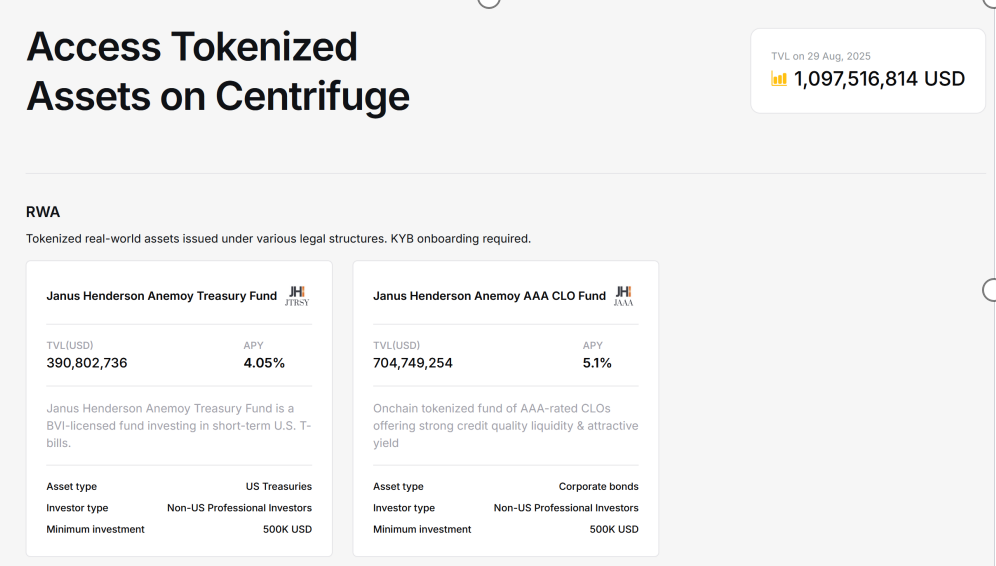
Source: Pharos Research, Centrifuge
Currently, the products open to investors on the Centrifuge platform focus on two categories: one is a tokenized U.S. Treasury product issued by the well-known fund company Janus Henderson; the other is structured AAA-rated collateralized loan obligation (CLO) shares. CLOs are financial products that package multiple floating-rate, lower-rated loans and structure them through SPVs to meet the needs of investors with different risk preferences. Both types of investment products are only available to qualified investors and are issued on the Ethereum network.
Additionally, recent series of moves clearly indicate that Centrifuge's strategic focus is fully shifting towards compliant scenarios and permissioned blockchains. In May 2025, the project announced it would join as one of the first launch partners in the compliant RWA dedicated chain Converge, jointly promoted by Securitize and Ethena. In June of the same year, Centrifuge reached a partnership with S&P Dow Jones to explore the development of a "Proof-of-Index" mechanism. Following that, in July, Centrifuge V3 was officially launched, integrating the Wormhole cross-chain architecture to achieve a multi-chain unified RWA infrastructure across six mainstream EVM chains, significantly enhancing its cross-chain liquidity and asset management capabilities.
3.3.5 Tradable: High-Performance Institutional Credit Platform Based on ZK Technology
Project official website:
https://www.tradable.xyz/
Project official X account:
https://x.com/tradable_xyz
Tradable currently focuses on bringing institutional-level private credit assets onto the blockchain and has achieved significant scale in this field. The platform has processed over $2.1 billion in on-chain private credit assets, completed 37 independent transactions, and provided investors with an average annualized return of over 11%.[6] Its core business is to provide institutional participants with an efficient and compliant tokenized credit investment channel.
To achieve a balance between high performance and compliance, Tradable has chosen to build on a permissioned blockchain based on ZkSync Era (ZK Stack) technology while maintaining compatibility with the Ethereum ecosystem. Its underlying smart contract system embeds strict compliance mechanisms, including KYC/AML verification, qualified investor certification, and asset transfer restrictions. This architecture determines that its service targets are primarily institutions and qualified investors, with ordinary retail investors currently unable to participate directly. All prospective investors must first open an account and undergo a comprehensive compliance review process to obtain investment qualifications. Additionally, the platform sets a high participation threshold for single transactions, typically requiring no less than $100,000.
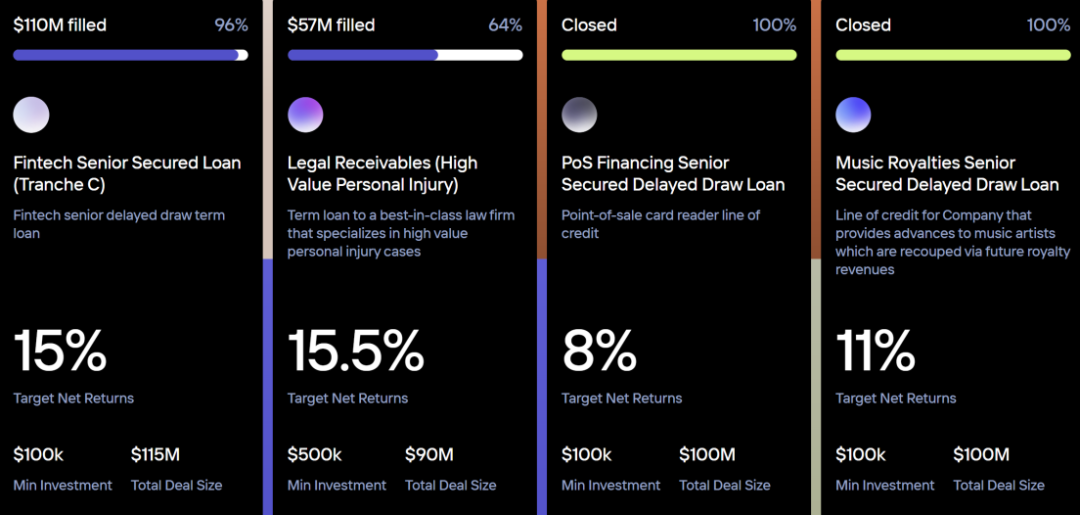
Source: Pharos Research, Tradable
3.3.6 PACT: Diversified Credit Solutions Incubated in the Aptos Ecosystem
Project official website:
https://pactfoundation.com/
Project official X account:
https://x.com/pactconsortium
Supported by the Aptos Foundation, the PACT protocol is dedicated to providing diversified financing solutions for emerging markets and specific regions through tokenized private credit products. To ensure the legal validity of its on-chain assets, PACT employs an innovative compliance framework: personal identifiable information (PII) is stored off-chain while being verified on-chain through hash values, a design that complies with the U.S. Uniform Electronic Transactions Act (UETA). All participants (including borrowers and investors) must undergo KYC/AML verification and obtain authorization before engaging in on-chain activities such as loan applications, NFT issuance, and lending contract transactions.
In the PACT ecosystem, each loan is represented by a dynamically updatable NFT, which not only records the loan terms and repayment status but also carries its transfer rights. Through collaboration with BitGo, these NFTs representing debt rights support resale and trading in the secondary market. Additionally, to address the secure storage of large-scale RWA data, PACT has partnered with the Shelby protocol (jointly launched by Aptos Labs and Jump Crypto) to utilize its high-performance, low-latency decentralized storage capabilities.
To date, the PACT platform has facilitated over $1 billion in loans. Its product portfolio showcases a high degree of regional and risk diversity, with some representative products introduced as follows:
• BSFG-EM-1: As its flagship product, this funding pool targets individual consumers and micro-entrepreneurs in emerging markets, providing short-term small loans with a scale exceeding $160 million and interest rates as high as 64.05%.
• BSFG-EM-NPA-1/2: These two are specialized asset pools for non-performing or defaulted loans, with a total scale of $184 million, open only to qualified investors, and their specific yields are not disclosed.
• BSFG-CAD-1: This pool is secured by Canadian residential properties, with a scale of $44.51 million, adopting a priority/subordinated layered structure. Its low interest rate of 0.13% may correspond to the lower-risk priority portion, but liquidity is restricted due to the assets being locked.
• BSFG-AD-1 and BSFG-KES-1: These two funding pools serve micro-enterprises in the UAE and the retail credit market in Kenya, with scales of $20.05 million and $6.39 million, respectively. Their interest rates reflect the high growth and high-risk characteristics of their respective markets, at 15.48% and 115.45%.
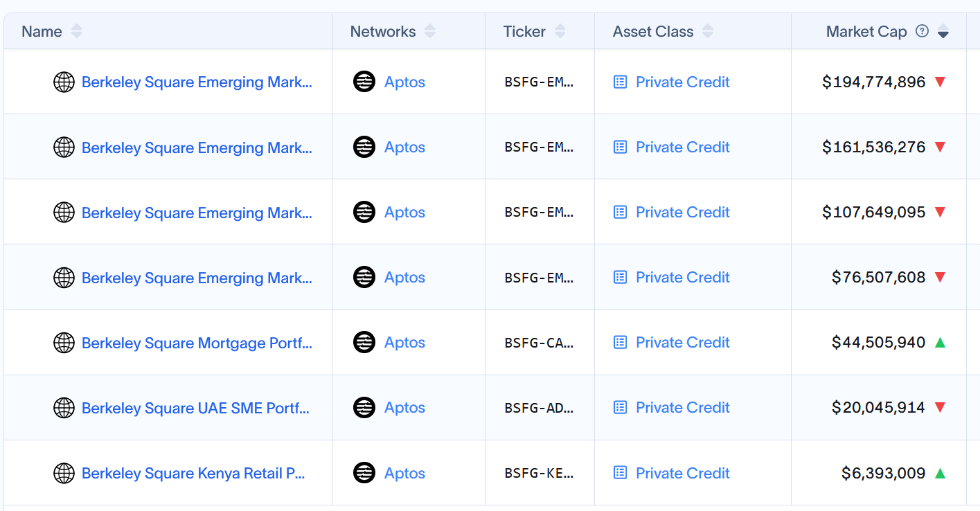
Source: Pharos Research, PACT Foundation
Source: Pharos Research, RWA.xyz
Looking ahead, PACT plans to integrate with mainstream DeFi protocols, aiming to introduce its credit tokens into a broader decentralized finance landscape, such as circular lending, leverage strategies, and liquidity mining, with expectations of providing investors with annualized returns of 6% to 15%.
3.4 Trends and Future Outlook
The on-chain private credit sector is transitioning from an early exploratory phase to a compliance-based, institution-led period of scaled expansion. Although top asset management institutions have taken the lead, the next phase of exponential growth in the market will depend on the breadth and depth of broader institutional participation—expanding from a few pioneers to a comprehensive entry of numerous small and medium-sized financial institutions. The true inflection point for future market scale will be the complete "institutionalization" of both the asset and funding sides, a profound structural shift expected to reshape the competitive landscape from three aspects:
First, the institutionalization of capital will inevitably require a mature regulatory framework, with "compliance-first" and "permissioned" environments becoming industry standards, replacing the past "wild growth" model.
Second, on this compliance foundation, the ultimate value of the sector will be released through deep integration into the DeFi ecosystem, transforming from mere "asset islands" providing returns to efficient, combinable assets that can be used as collateral by mainstream lending protocols.
Third, to meet increasingly complex institutional demands, underlying assets will continue to innovate from standardized loans to more diverse products such as Real Estate Investment Trusts (REITs) and Collateralized Loan Obligations (CLOs), collectively shaping a more mature, integrated, and expansive new landscape for on-chain credit.
These three trends are interlinked, collectively outlining a clear path toward maturity for the on-chain private credit sector. The future market will no longer be a simple on-chain reflection but will deeply integrate the asset depth and compliance rigor of traditional finance with the efficient settlement and combinability of decentralized finance. At that time, on-chain private credit is expected to shed its early labels of high risk and volatility, truly transforming into the "stable income cornerstone" of the entire on-chain economy, providing sustainable and low-correlated cash flows derived from the real economy for the digital asset world.
04 Core Sector Analysis: Commodities
4.1 Market Overview and Operational Mechanism
In the sub-sector of RWA (excluding stablecoins), tokenized commodities are an important component that cannot be overlooked. This category currently ranks third with an asset scale of $2.4 billion, accounting for 8.6% of the total market. Notably, it has shown strong growth momentum, with an increase of approximately 136% in asset scale since the beginning of the year.
The issuance mechanism for such RWAs generally follows a standardized process, including physical custody, on-chain mapping, and redeemable design, thereby constructing a complete closed loop. First, the issuer deposits physical assets such as gold into a regulated professional custodian to ensure that each unit of the on-chain token is backed by real physical assets. Subsequently, through smart contracts on the blockchain (primarily Ethereum), tokens anchored to the physical assets are issued at a 1:1 ratio. Finally, users can redeem their held tokens for the corresponding physical assets, provided they meet compliance requirements. Although these tokens generally require users to complete KYC verification during the minting and burning phases in the primary market, as standard ERC-20 tokens, they can circulate freely in the secondary market. Their on-chain holding address count (approximately 83,000) and monthly trading volume (approximately $1.13 billion) are significantly higher than other RWA categories such as tokenized stocks, although their trading activity is still primarily concentrated on centralized exchanges.

Source: Pharos Research, RWA.xyz
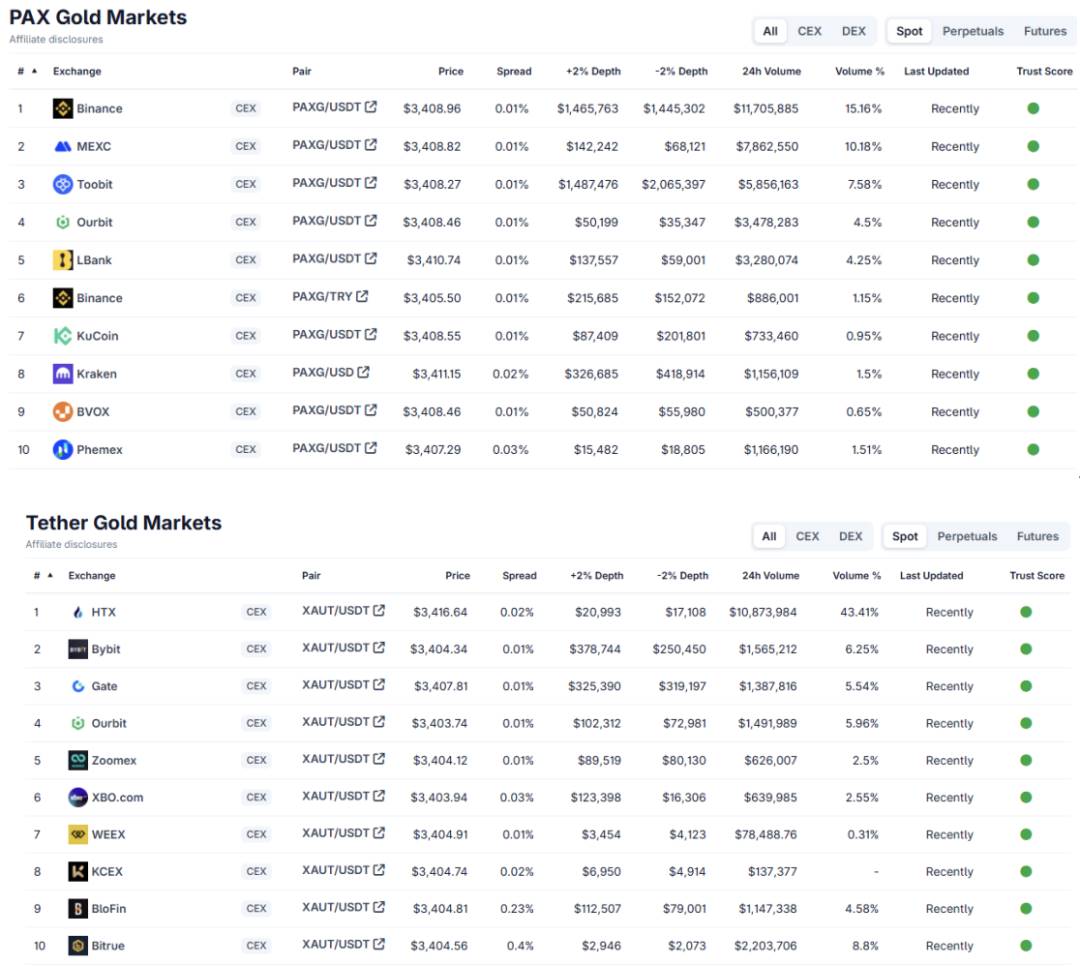
Source: Pharos Research, CoinGecko
4.2 Market Structure
Currently, the tokenized commodities market exhibits a highly concentrated duopoly. The vast majority of the underlying assets are gold, with Paxos' PAXG (market cap $960 million) and Tether's XAUT (market cap $840 million) respectively holding 40.7% and 35.6% of the market share, collectively controlling over 75% of the market.

Source: Pharos Research, RWA.xyz
However, despite their large market capitalization and trading volume, the integration of PAXG and XAUT into decentralized finance (DeFi) protocols is extremely limited. Currently, no mainstream lending protocols support these two assets as collateral. Although the Aave protocol briefly launched the collateral feature for PAXG, it was eventually removed due to low liquidity. While there are related liquidity pools in decentralized exchanges like Uniswap and Curve, the total locked value (TVL) of these pools is generally small, and trading depth is severely lacking. This means that users, apart from providing liquidity to earn trading fees, can hardly use these assets for lending, yield aggregation, structured derivatives, and other core DeFi modules, and their combinability advantages as RWA assets have yet to be fully explored.
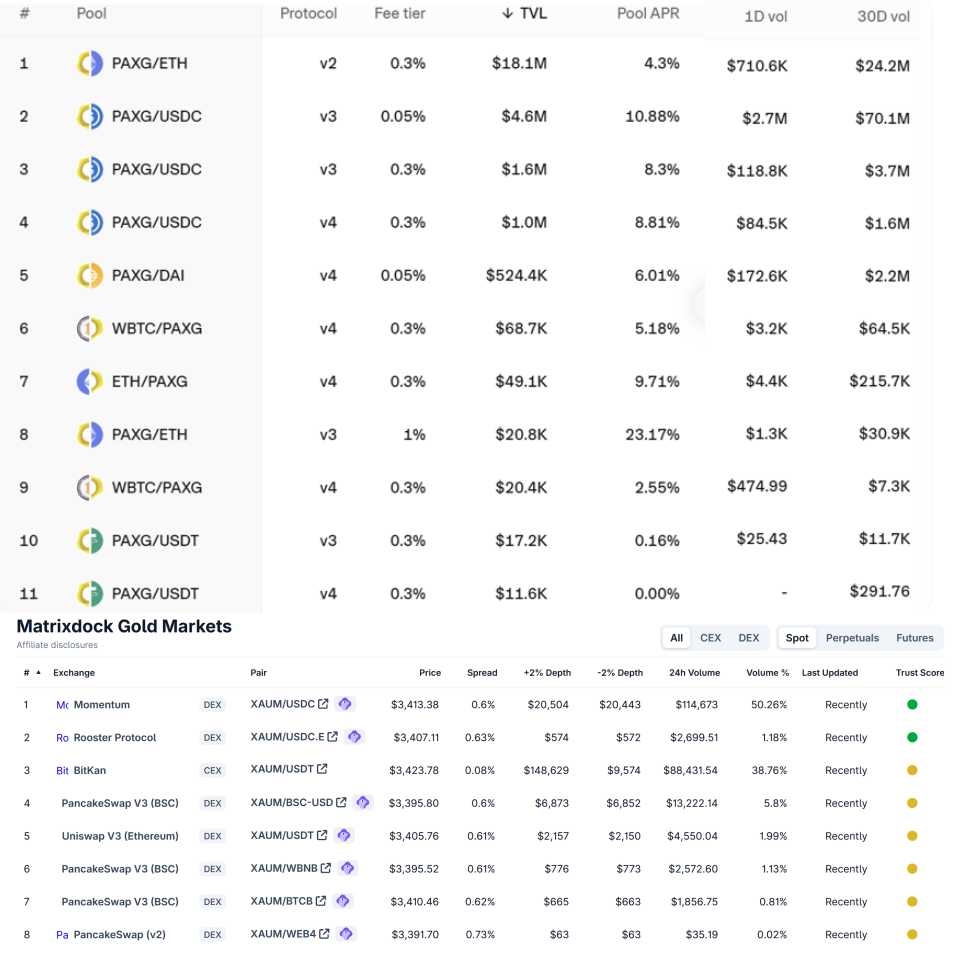
Source: Pharos Research, CoinGecko
4.3 Trends and Future Outlook
Although the current market is dominated by a few leading projects, a clear trend is the increasing diversification of issuing entities, expanding from crypto-native institutions to a broader range of traditional listed companies and financial entities. Matrixport's Matrixdock has launched its tokenized gold product, and more significantly, Nasdaq-listed Blue Gold Limited (NASDAQ: BGL) has announced plans to issue BGC tokens. The underlying assets are not traditional physical gold but forward contracts for gold to be delivered in the future, marking an important step in the complexity and innovation of tokenized commodities in financial products.
Looking ahead, the boundaries of tokenized commodities will extend from precious metals to broader fields, and the technology selection will also present a multi-chain coexistence pattern. For example, Singapore-based agricultural trading company Davis Commodities Ltd. plans to build an on-chain trading platform to introduce bulk agricultural products such as white sugar and rice into the tokenized world for the first time. Additionally, the cross-industry collaboration between U.S. medical device company BioSig and Streamex plans to issue gold tokens on the Solana blockchain, indicating that future asset issuance will no longer be limited to Ethereum. The entry of these newcomers is expected to inject new vitality into the market and may fundamentally break the existing duopoly, opening a new development phase with more diverse asset types and broader participation.
05 Core Sector Analysis: Stocks
5.1 Market Overview
Tokenized stocks serve as a bridge linking traditional finance and the digital asset world, holding immense potential within the future RWA industry. The market participants can mainly be categorized into three types: emerging market retail investors seeking access to U.S. stock investments, traditional finance practitioners (or high-net-worth individuals) intending to manage positions, and quantitative trading institutions looking to exploit arbitrage opportunities.
Compared to NVIDIA (NASDAQ: NVDA), which has a market capitalization of $4.4 trillion, the total market capitalization of all tokenized stocks currently stands at only $359 million. This highlights that the sector is still in its very early stages, with significant imaginative space and enormous potential. On the other hand, it also reflects the challenges faced by the industry: limited participants and severe liquidity shortages.
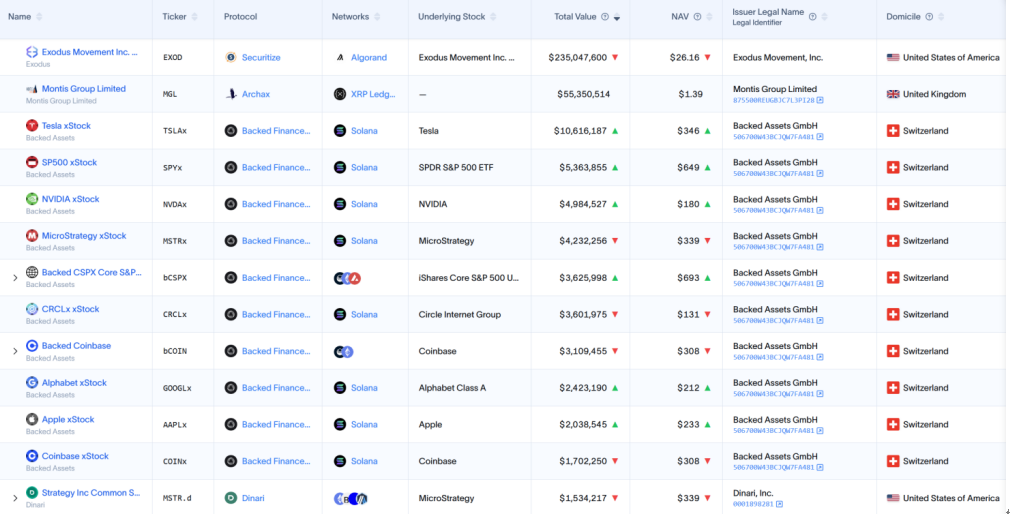
Source: Pharos Research, RWA.xyz
Deconstructing the existing market size reveals a rather unique composition. The top-ranked EXOD (over $235 million) is a native equity on-chain under a compliance framework established in 2021, differing from mainstream stock mapping models; while the second-ranked MGL is an experimental product within the UK's regulatory sandbox, which cannot circulate freely. Excluding these two special projects, the current active tokenized U.S. stock market exhibits a highly concentrated characteristic, with the xStocks series of products issued by Backed Finance holding an absolute dominant position, while tokenized products from Dinari and Swarm have also gained some market attention.
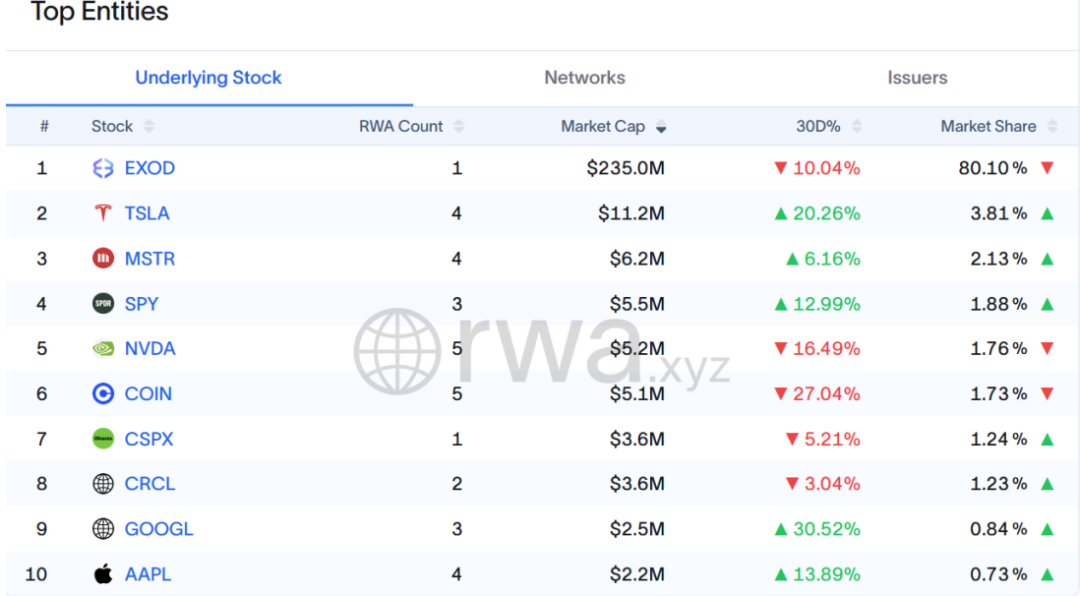
Source: Pharos Research, RWA.xyz
In terms of the types of underlying assets, the current market for tokenized targets shows a clear strategic preference, mainly concentrated in two categories: one is stocks of globally renowned high-tech companies such as the "Tech Giants," and the other is stocks of publicly listed companies highly correlated with the crypto market, such as Coinbase (NASDAQ: COIN) and MicroStrategy (NASDAQ: MSTR). Among these, the tokenized product of Tesla (NASDAQ: TSLA) is the only target with a market capitalization exceeding $10 million, while the market size of other products mostly falls within the million-dollar range, indicating that the overall market depth remains shallow.
5.2 Market Operation Model Analysis
From the perspective of implementation paths, the mainstream tokenized stock issuance models in the current market can be broadly categorized into three types, with significant differences in supporting assets and investor rights.
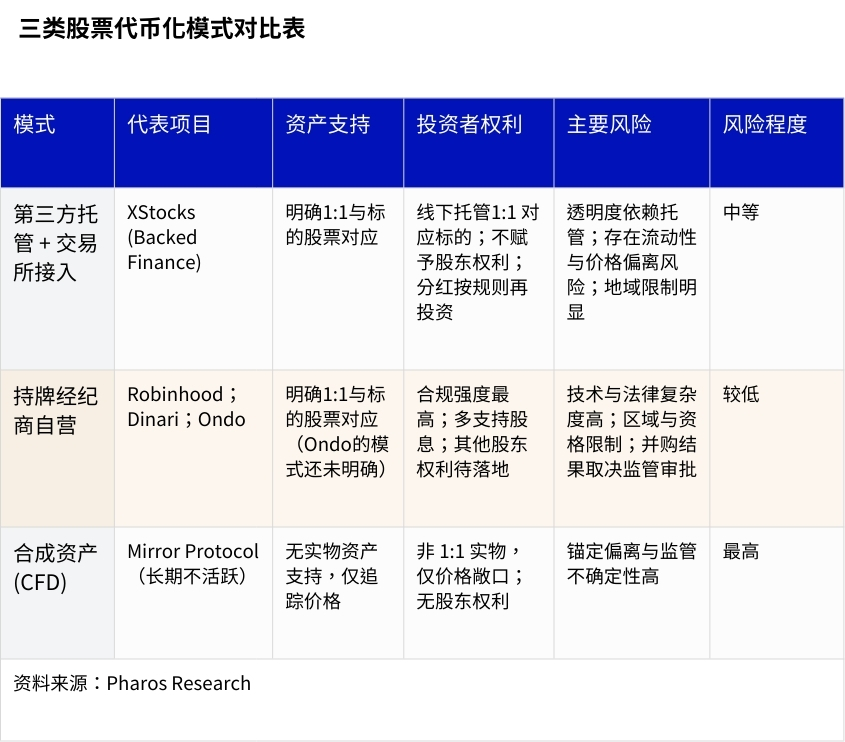
• Third-party Custody and Exchange Access Model: This model is represented by xStocks, where the issuer Backed Finance holds real stocks through a special purpose vehicle (SPV) and provides asset guarantees through an independent off-chain custodian. Ultimately, the product offers trading services to users through centralized exchanges such as Kraken and Bybit. According to platform disclosures, xStocks aims to reflect the price and behavior of the underlying stocks without granting shareholder rights (such as voting and claims to residual assets), with dividends automatically reinvested into the same token balance according to rules. This model uses an oracle for price anchoring, but its transparency and the authenticity of the assets heavily rely on the custodian's credibility.
• Licensed Broker-Dealer Proprietary Model: This path is operated by entities qualified for securities business, providing a closed loop for issuance and settlement. For example, Robinhood utilizes its broker-dealer license to directly offer a complete closed-loop service from issuance, trading to settlement on the blockchain (currently on Arbitrum, with future plans for its own L2). Similarly, projects like Ondo Finance and Dinari have obtained broker-dealer licenses recognized by the U.S. SEC through acquisition or registration, thus qualifying for compliant issuance and settlement of tokenized securities. This path has the highest compliance intensity but also comes with significant technical and legal complexities.
• Contract for Difference (CFD) Model: A typical representative of this model is the now-defunct Mirror Protocol. Users receive synthetic derivatives linked to stock prices, rather than a 1:1 on-chain mapping of physical stocks, and thus do not enjoy shareholder rights. This path relies on price feeds and market making, making it susceptible to pricing deviations and regulatory uncertainties, leading to significant regulatory pressure and asset decoupling risks for the platform.
It is worth noting that the aforementioned issuance models (especially the first and second) are not distinctly separate in practice but exhibit significant overlap and a trend of dynamic evolution. On one hand, licensed issuers often combine third-party custody and external exchange access strategies to enhance asset transparency and market liquidity. On the other hand, unlicensed project parties are actively seeking to obtain broker-dealer qualifications through applications or acquisitions, moving closer to the proprietary model. Strictly speaking, the only issuer currently achieving end-to-end vertical integration is Robinhood. Even Dinari, which has obtained key broker-dealer licenses, is still in the early stages of building an independent proprietary system and currently relies on third-party custody to support its core business.
5.3 Key Compliance License Analysis
In the U.S., tokenizing stocks and other securities and providing trading services is a highly regulated financial activity that must be conducted within the framework of the U.S. Securities and Exchange Commission (SEC) and the Financial Industry Regulatory Authority (FINRA). Any project wishing to build a fully compliant end-to-end tokenized stock ecosystem typically needs to obtain the following three key licenses.

These three licenses together form a complete business closed loop, with the difficulty of obtaining them roughly ordered as follows: Transfer Agent (TA), Broker-Dealer (BD), Alternative Trading System (ATS).
• The core function of a Transfer Agent (TA) is to act as the official "shareholder registry custodian" for the securities issuer, responsible for accurately tracking and recording ownership of securities. In tokenization business, the role of the TA becomes particularly critical, as it is the cornerstone for ensuring that on-chain digital certificates accurately map to off-chain legal rights. The TA is responsible for maintaining the authoritative legal registry of token holders, meaning that regardless of how the on-chain wallet addresses circulate, the ultimate legal beneficiaries of the assets can be confirmed. This function is crucial for resolving ownership disputes and ensuring accurate distribution of dividends and other rights, serving as the trust foundation of the entire asset tokenization compliance system.
The Broker-Dealer (BD) license is the passport for engaging in all securities business, authorizing entities to execute securities trades on behalf of others or for their own accounts. In the context of tokenized stocks, this license is the legal prerequisite for platforms to handle users' primary market operations in compliance. Specifically, whether users purchase tokens using fiat or stablecoins (i.e., "minting") or sell tokens to retrieve funds (i.e., "redeeming"), the underlying stock transactions and settlements must be executed by entities holding a BD license. Therefore, the BD license constitutes the core compliance hub connecting investors with the primary issuance of tokenized assets.
• The Alternative Trading System (ATS) license authorizes entities to operate a regulated secondary market trading platform, providing legitimate matching services for securities not listed on national exchanges. For tokenized stocks, the ATS license is the key to unlocking their true liquidity. If a platform only holds the first two types of licenses, it can only handle the issuance and redemption of assets but cannot facilitate legal peer-to-peer trading among users. Only by obtaining an ATS license can a platform build a compliant secondary market, enabling effective price discovery, enhancing asset turnover efficiency, and ultimately addressing the long-standing liquidity challenges faced by tokenized assets.
Based on the aforementioned core license framework, the current market also presents two noteworthy points regarding compliance path selection:
First, it is essential to clearly distinguish the boundaries between securities business and money service licenses. The aforementioned TA/BD/ATS constitute the indispensable "orthodox" compliance path for engaging in tokenized stock business in the U.S. Some project parties mention the MSB (Money Services Business) license in their promotions, which governs businesses such as money transfers and does not replace the legal functions of securities licenses in any form.
Second, due to the extremely high compliance thresholds in the U.S. market, industry pioneers have demonstrated a clear trend of convergence: bypassing the U.S. and choosing to establish operational bases in jurisdictions with clearer regulations in Europe. For example, Robinhood relies on a Lithuanian license to issue derivatives under the EU MiFID II framework; while Backed Finance (xStocks) operates based on Switzerland's DLT law. Although the legal paths differ, their strategic goals are aligned—under compliant conditions, they aim to target the vast non-U.S. market as their core business objective.
5.4 Major Players
5.4.1 xStocks (Backed Finance): Compliant On-Chain Stock Price Tracking Certificates
Project official website:
https://xstocks.com/
Project official Twitter account:
https://x.com/xstocksfi
xStocks, issued by the Swiss compliant asset tokenization platform Backed Finance, is a representative product of the open model in the tokenized stock sector (Backed Finance also issues btoken, which tracks the price of publicly traded securities such as ETFs, stocks, and government bonds).
Since June 30 of this year, the xStocks series of products have been successively launched on mainstream exchanges such as Bybit, Kraken, and Gate.io (some support leverage and short-selling mechanisms). Its core operational model is to entrust the 1:1 corresponding real stocks to regulated third-party institutions such as InCore Bank for custody, and after initially launching on the Solana public chain, it has further expanded its issuance network to BNB Chain and TRON, demonstrating a clear multi-chain development strategy. Currently, the Backed Finance platform offers over 60 types of U.S. stock tokens, with its popular products occupying an absolute dominant position in the active tokenized U.S. stock market.
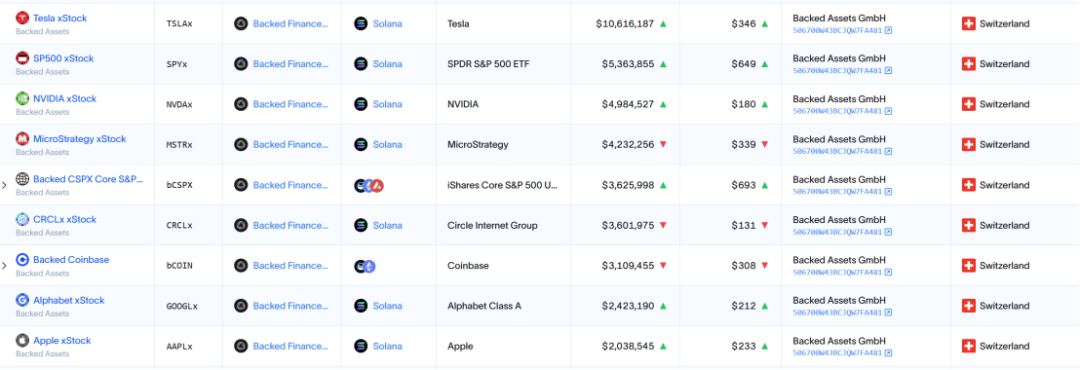
Source: Pharos Research, RWA.xyz
The ecosystem construction of xStocks demonstrates a clear strategic hierarchy. Its market entry is primarily driven by the core issuer Backed Finance in collaboration with top distribution channels Bybit and Kraken, the latter providing critical initial liquidity and user reach. Based on this foundation, xStocks actively integrates into the DeFi ecosystem of its native blockchain Solana, aiming to connect on-chain trading with core scenarios such as collateralized lending through integrations with leading DEX aggregators like Jupiter, automated market makers like Raydium, and lending protocols like Kamino Finance. Ultimately, the project broadens user access through collaboration with payment gateway Alchemy Pay and launches products in partnership with African cryptocurrency exchange VALR, showcasing its global vision for expansion into emerging markets.

Source: Pharos Research, Backed Finance
(1) Market Liquidity Performance
From the perspective of market liquidity data, xStocks' market performance is mixed. According to Dune data, the total on-chain trading volume of xStocks is currently $600 million, while the exchange trading volume is $3.46 billion (with CEX trading volume accounting for over 95%). Its on-chain trading is primarily concentrated on Raydium, but the depth of the liquidity pools and trading volume for core trading pairs is severely lacking compared to mainstream trading pairs like SOL/USDC, indicating low capital efficiency in on-chain market making. However, its spot trading volume on centralized exchanges far exceeds that on-chain, with estimates suggesting that its total spot trading volume could rival that of some mid-sized altcoins. Nevertheless, whether on-chain or off-chain, insufficient liquidity depth remains a core challenge, leading to low transaction efficiency for users and a noticeable gap in overall trading experience compared to traditional financial platforms.
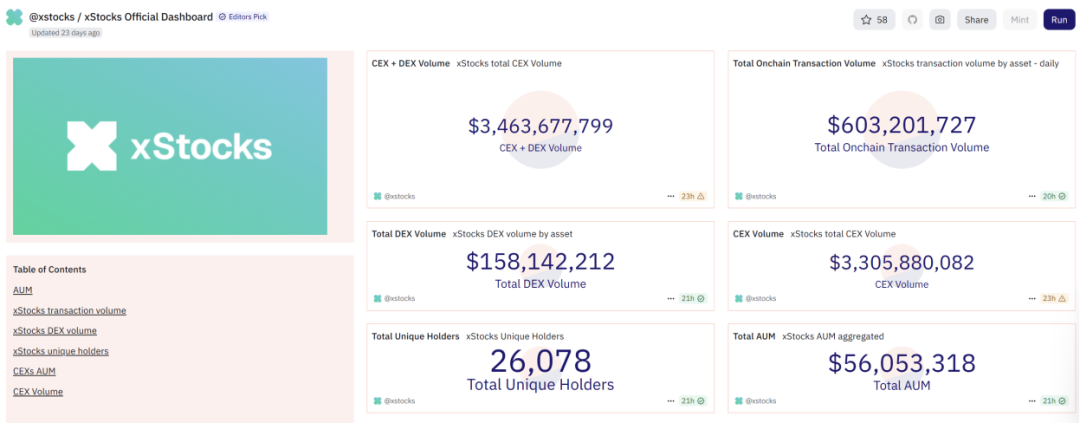
Source: Pharos Research, Dune
(2) Issuance and Custody Mechanism
The issuance process of xStocks constructs a complete closed loop linking traditional financial markets and blockchain. According to publicly available information, its operational process is as follows: First, the parent company registered in Switzerland instructs its entity located in Jersey (Backed Assets) to purchase corresponding stocks in the U.S. secondary market through the Prime service channel of mainstream brokers like Interactive Brokers. Subsequently, these stocks are transferred and held in a segregated account at Clearstream, a custodian under Deutsche Börse. Once the stocks are securely deposited, this action triggers a smart contract deployed on the Solana blockchain to mint the corresponding xStocks tokens (e.g., TSLAx) at a 1:1 ratio. Finally, these tokens can be directly listed for trading on exchanges like Kraken and Bybit. Conversely, investors holding sufficient tokens can also apply to Backed Finance to redeem their tokens for real stocks.
(3) Nature of the Token: Corporate Debt Tracking Stock Prices
According to mainstream views within the industry, xStocks is not an equity token in its legal structure; its essence is a type of corporate debt that tracks the price of underlying assets. This clever design brings several key characteristics: First, the issuing entity (usually an SPV) does not require custody qualifications, and distribution is handled by entities with the appropriate licenses (such as Kraken's Bermuda subsidiary). Second, due to its bond-like nature, dividend distribution can be simplified to directly airdropping more tokens to holders, without involving complex corporate actions such as voting rights. Most importantly, as a bearer bond, its ownership transfer on-chain does not require registration, thus avoiding stamp duties in traditional equity trading and achieving frictionless on-chain circulation. However, this model also has limitations; its higher trading spreads and fees determine that its current core value still lies in providing users with exposure to U.S. stock prices, falling short of true institutional-level applications.
(4) Major Risks and Controversies: Founding Team Background
A significant risk point for xStocks lies in the past background of its founding team. According to disclosures from the crypto community, the core founding team of Backed Finance was previously co-founders of the project DAOStack. After raising approximately $30 million through an ICO in 2018, DAOStack essentially ceased operations in 2020, and its token GEN nearly went to zero. This historical situation brings a degree of uncertainty to Backed Finance's long-term credibility, constituting a reputational risk that potential investors and partners need to carefully assess during due diligence.
5.4.2 Robinhood: Seamlessly Bringing Zero-Commission U.S. Stock Trading On-Chain
The well-known internet brokerage Robinhood has chosen a model in the tokenized stock sector that is entirely different from the open path, aiming to build a vertically integrated closed ecosystem. Leveraging its compliance license obtained in Lithuania as the cornerstone for entering the EU market, it has provided users with over 200 tokenized U.S. stock and ETF products, with plans to expand to thousands by the end of 2025. On the technical side, its tokens initially operate on the Arbitrum network, with plans to eventually migrate to a self-developed Arbitrum-based Layer 2 to enhance efficiency. For users, this model offers an attractive and convenient experience with 24/5 trading, zero commissions, and direct deposit of dividends.
However, from the nature of the assets, these "stock tokens" are not equity in the traditional sense. Its CEO Vlad Tenev has clarified that they are blockchain-based derivative contracts designed to track the price of the underlying assets, but investors do not enjoy shareholder rights such as voting rights (though they do receive shareholder dividends)—despite Robinhood claiming to hold 1:1 asset reserves to support such derivatives. On this basis, Robinhood's strategy goes beyond mature stocks; its more innovative move is to lay out alternative assets, being the first to launch tokenized derivatives for non-public companies like OpenAI and SpaceX (OpenAI has officially clarified that it did not participate in the collaboration), providing users with a unique channel to access high-barrier Pre-IPO assets.
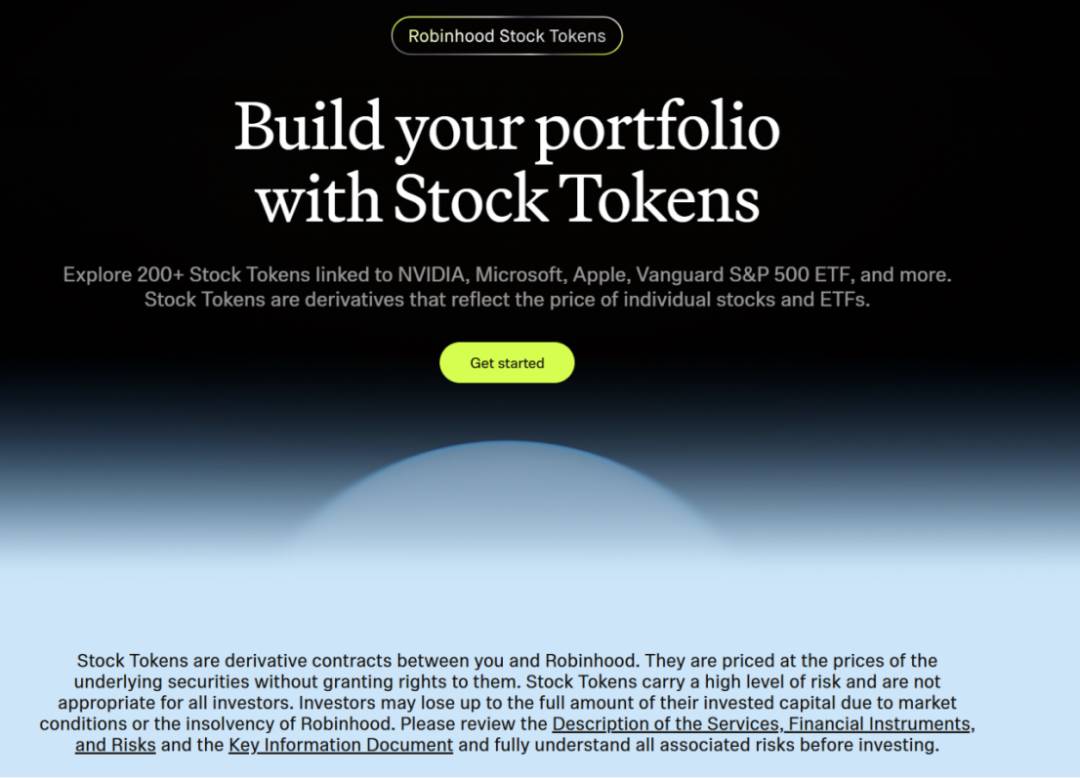
Source: Pharos Research, Robinhood
The fundamental difference between Robinhood's model and the open paths like xStocks lies in its extreme pursuit of compliance and the strategic trade-offs that come with it. Robinhood's stock token contracts embed strict compliance restrictions, requiring every on-chain transfer to pass through an approved wallet registry (i.e., KYC/AML whitelist) check. Any transfer to a non-whitelisted address will be automatically blocked by the smart contract.
The direct consequence of this design is that its token assets completely sacrifice the composability to interact with permissionless DeFi protocols. However, this also constitutes its core moat: by building a fully controllable, highly compliant closed-loop ecosystem, Robinhood can minimize regulatory risks and attract a mainstream user base and centralized finance (CeFi) partners with high compliance requirements. This is a clear strategic choice—sacrificing the flexibility of open finance in exchange for greater access to compliant market scale.
5.4.3 Dinari: A Securities Token Platform Holding Key U.S. Licenses
Project official website:
https://dinari.com/dshares
Project official X account:
https://x.com/DinariGlobal
In the tokenized stock sector, Dinari positions itself as a compliance-focused underlying infrastructure service provider, leveraging its "Broker-Dealer" license obtained in the U.S. to potentially pave the way for the issuance and trading of tokenized stocks within the U.S. Its core product dShares™ covers over 100 U.S. stocks and ETFs and has been deployed on Arbitrum and Ethereum mainnets, demonstrating strong liquidity.
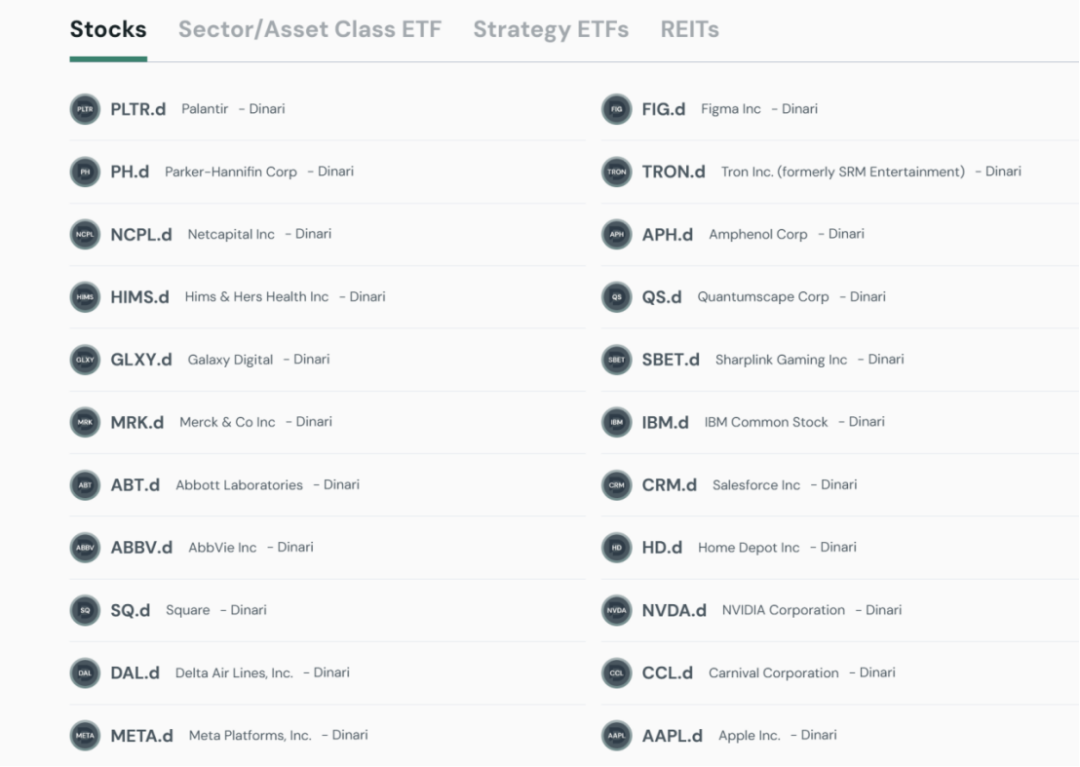
Source: Pharos Research, Dinari
(1) Regulatory Compliance and License Advantages
Dinari's core competitive advantage stems from its strong regulatory compliance. Its subsidiary successfully obtained the "Broker-Dealer" license from the Financial Industry Regulatory Authority (FINRA) in June 2025, making it the first project platform dedicated to this business to acquire this key qualification. Additionally, its parent company Dinari, Inc. is also registered as a "Transfer Agent" with the U.S. SEC.
(2) Product Analysis: 1:1 Asset Support and Rights Structure
Dinari's core product line consists of the tokenized securities dShares™ and the yield-bearing stablecoin USD+. dShares™ is defined as "securities tokens" within mainstream views, with a rigorous and transparent operational model: an independent special purpose vehicle (SPV) purchases corresponding stocks or ETF assets in the U.S. market, and then issues tokens on the blockchain at a 1:1 ratio, with all underlying assets held and audited by third-party institutions. In terms of shareholder rights, dShares™ holders are entitled to receive dividends from the corresponding stocks, but currently do not possess voting rights or complete shareholder status.
There has been ongoing controversy regarding the product nature of dShares™. In the EU compliance document (PRIIP KID), dShares are described as "over-the-counter derivative contracts linked 1:1 to the underlying"; Dinari has consistently referred to them as Tokenized Securities. However, considering the fact that they provide dividends and strive to meet shareholder rights, the market generally defines them as securities products, with the only difference being the compliance terminology (derivative contracts/tokenized securities) varying slightly by jurisdiction.
In terms of market expansion, Dinari announced a partnership with Gemini exchange in August 2025, marking its transition from primary market redemptions to a compliant centralized secondary market, beginning to offer services to European investors and innovatively introducing night trading hours. However, the initial liquidity and scale of the market remain significant challenges. According to RWA.xyz data, even its most popular tokenized MicroStrategy (NASDAQ: MSTR) stock MSTR.d currently has a market cap of only about $1.5 million, indicating that the market is still in the early cultivation stage.
5.4.4 Ondo Finance: RWA Giant Enters the Tokenized Stock Market
Project official website:
https://ondo.finance/
Project official X account:
https://x.com/OndoFinance
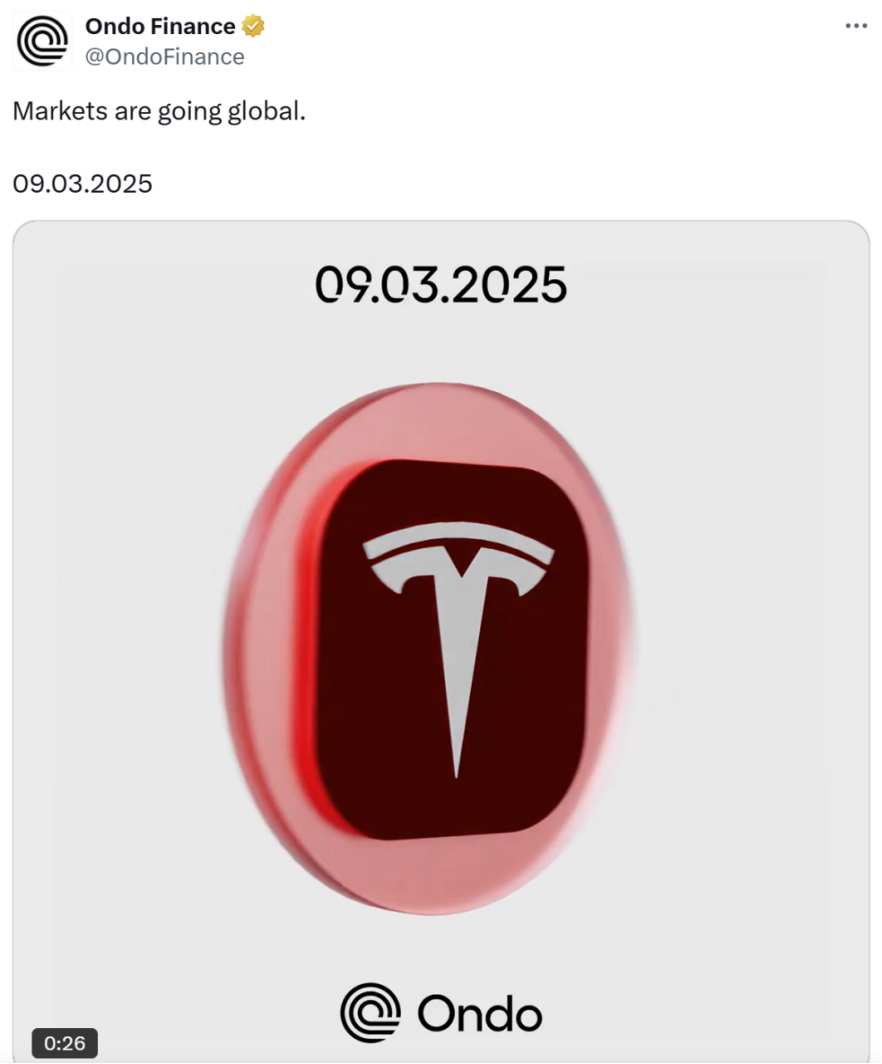
Source: Pharos Research, Ondo Finance
As a recognized leader in the tokenized U.S. Treasury market, Ondo Finance acquired a full set of stock licenses through the acquisition of U.S. brokerage Oasis Pro in July 2025, marking its determination to enter the tokenized stock market. It plans to launch the on-chain U.S. stock trading platform "Ondo Global Markets" on September 3, offering tokenized products for 100 stocks initially, with a long-term goal of expanding to thousands. With its proven execution capabilities and strong brand reputation in the RWA field, Ondo's entry will pose a strong challenge to the existing market landscape.
Ondo's strategic layout demonstrates a clear "DeFi native" orientation and strong ecosystem-building capabilities. On the product level, its platform plans to provide 24/7 stock trading for non-U.S. users and clearly states that its tokenized stocks can be used as collateral in DeFi protocols, which is in stark contrast to the closed models like Robinhood. On the ecosystem level, Ondo has taken the lead in establishing the "Global Markets Alliance," with initial members including the Solana Foundation, institutional custodian BitGo, and key participants like leading DEX aggregator Jupiter, aiming to jointly formulate industry standards for RWA and build a strong, cross-domain collaborative network.
Ondo's core advantage lies in its established compliance moat and market credibility. By completing the acquisition of Oasis Pro in July 2025, Ondo obtained a full set of licenses, including Transfer Agent (TA), Broker-Dealer, and Alternative Trading System (ATS), laying a solid foundation for its compliant operations in the U.S. The combination of a strong brand reputation, top-tier ecosystem alliances, and solid compliance licenses constitutes Ondo Finance's core competitiveness, making it one of the most promising giants in the tokenized stock sector.
5.5 Arbitrage Logic and Opportunity Analysis for Tokenized Stocks
The close connection and significant efficiency differences between the tokenized stock sector and traditional stock markets have created enormous arbitrage opportunities. Specifically, these opportunities arise from two aspects of efficiency differences:
First is the significant liquidity gap: According to RWA.xyz data, as of August 28, 2025, the total market cap of all stock tokens is approximately $359 million, which is even less than the market cap of NVIDIA (NASDAQ: NVDA) single stock at $4.4 trillion. This severe lack of liquidity makes token prices more susceptible to volatility when faced with larger trades. Second is the mismatch in trading hours: the crypto market offers 24/7 uninterrupted trading, while traditional stock markets have fixed opening and closing times.
These two core factors together lead to temporary deviations in token prices and the prices of underlying stocks across different platforms and time periods, providing two distinct approaches for professional institutional practitioners and individual investors.
5.5.1 Core Arbitrage Strategies for Institutions
Large-scale and effective arbitrage strategies often have high requirements for technology, capital, and speed of information acquisition, making them more suitable for institutions or professional quantitative teams. Specifically, there are three common arbitrage approaches:
• Cross-Market Hedge Arbitrage: This strategy exploits the price difference between tokens and spot stocks. When both markets open simultaneously, if the token price is significantly higher than the spot price, arbitrageurs can buy the spot stock while shorting the corresponding token in the token market. When the price difference converges, they can lock in profits by closing their positions through reverse operations. This strategy is highly sensitive to trading slippage and fees, requiring low-latency, high-frequency automated trading execution capabilities.
• Cross-Platform Price Arbitrage: This is a classic arbitrage model in the crypto market, where tokens are bought on a platform with lower prices and quickly transferred to a platform with higher prices for sale. The success of this strategy is limited by various factors such as on-chain transfer speed, exchange deposit and withdrawal restrictions, and trading pair depth, often requiring arbitrageurs to pre-deposit liquidity on multiple platforms and operate in coordination through quantitative programs.
• Time-Difference Information Arbitrage: This is the most distinctive strategy in the tokenized stock market, focusing on exploiting the trading time differences between two markets. Non-trading periods in traditional stock markets (such as weekends and pre/post-market hours) are often when significant news (such as company earnings reports or macro policies) is released. Since stock tokens can be traded 24/7, their prices react to this information before the spot market. Arbitrageurs can deploy high-performance news monitoring systems to capture significant news during non-trading periods, predict its impact on stock prices, and establish positions in the token market in advance (going long for positive news and short for negative news), closing their positions once the traditional market opens and prices reflect expectations. This arbitrage window is extremely short, often measured in minutes or even seconds, placing extreme demands on information acquisition speed and automated trading response capabilities.
It is worth noting that the issuing platform itself typically deploys corresponding anti-arbitrage mechanisms to maintain asset stability. The most common strategy is to strictly anchor the minting and redemption of tokens in the primary market to the actual transaction prices and times of the physical stocks held in its platform's custody accounts. This mechanism effectively prevents direct counterparty arbitrage targeting the issuing platform and avoids asset loss due to systemic price differences. Therefore, the aforementioned arbitrage strategies, especially the time-sensitive "information arbitrage," are most feasible not in the primary market through minting/redemption operations against the platform, but in the platform's own DEX or other secondary markets that support the free circulation of the token.
5.5.2 Core Value Proposition for Retail Investors
Although complex arbitrage strategies are not the domain of ordinary investors, the emergence of tokenized stocks fundamentally improves the experience of retail investors participating in global quality asset investments, with its core value proposition reflected in the following three aspects:
• Lowering Investment Barriers (Fragmented Investment): The traditional U.S. stock market typically has a minimum trading unit of 1 share, making participation in high-priced stocks like Google and Tesla relatively high for ordinary investors. Tokenization technology supports the "fragmentation" of stocks, allowing users to purchase 0.1 shares or even 0.001 shares, achieving true "fractional ownership" and greatly enhancing the inclusiveness of investment.
• Enhancing Market Accessibility (All-Day Trading): Breaking free from the opening time restrictions of traditional stock markets, the 24/7 trading mechanism provides retail investors with unprecedented flexibility. Investors can enter and exit the market at any time, respond instantly to unexpected events in any global time zone, and conduct flexible allocations across time zones and multiple assets, effectively mitigating regional risks.
• Improving Settlement Efficiency and Capital Efficiency (T+0 Settlement): Traditional securities trading follows a T+2 settlement cycle, requiring two business days to complete the delivery of funds and securities, which occupies a significant amount of capital and introduces settlement risks. In contrast, tokenized stocks achieve near real-time (T+0) atomic settlement based on blockchain technology, where trading equals final delivery. This model not only greatly enhances the efficiency of capital utilization but also fundamentally reduces counterparty risks in the clearing process, showcasing structural advantages over traditional financial infrastructure.
However, there are still cautious views in the market regarding whether tokenized stocks can fundamentally improve the regional liquidity of traditional equity assets. Although theoretically, stock tokenization breaks geographical restrictions, allowing quality assets like U.S. stocks to circulate globally, its current contribution to the liquidity of the stock market itself remains limited. This primarily stems from two core realities:
First, the current users who can proficiently participate in on-chain investments often possess the knowledge and operational capabilities to invest directly in U.S. stocks through other channels, leading to a high overlap between the two investor groups. Second, and more critically, there is a significant scale difference between the two markets—the global stock market has a market cap of several trillion dollars, far exceeding the current crypto market, which means that liquidity transmission is currently one-way, with traditional assets bringing value to the crypto world rather than the other way around—of course, this asymmetric pattern may change in the future as the digital asset market evolves.
In summary, tokenized stocks systematically address the three major pain points faced by retail investors in traditional markets—capital barriers, time constraints, and trading friction—through "fragmented ownership," "all-day trading," and "low-cost circulation," fundamentally empowering individual investment rights.
5.6 Outlook on the Trend of Stock Tokenization
Looking ahead, the tokenized stock sector is evolving along two overlapping but potentially coexisting paths, both of which are underpinned by increasingly stringent compliance frameworks.
The first path is represented by Robinhood's "compliance walled garden" model. The vision of this model is to rely on the issuer's own brokerage licenses to provide vertically integrated services from issuance, trading to settlement within a self-built or controllable blockchain environment (such as L2). Its core advantage lies in maximizing the compliance of business processes by embedding KYC/AML into the underlying smart contracts, creating a closed but secure environment that is more easily accepted by mainstream users and regulatory agencies. However, the cost of this is the sacrifice of composability with the broader DeFi world, as token assets cannot circulate freely in permissionless protocols.
The second path is represented by xStocks (Backed Finance) as the "open finance bridge" model. This model chooses to issue standardized tokens on high-performance public chains like Solana, aiming to leverage the native advantages of blockchain to deeply integrate with decentralized exchanges (DEX) and lending protocols, maximizing asset liquidity and capital efficiency. Although this path aligns more with the open spirit of the crypto world, it also faces greater regulatory uncertainty at this stage, often requiring measures such as geographic restrictions (e.g., excluding U.S. users) to mitigate potential legal risks.
Ultimately, regardless of the path taken, addressing the insufficient liquidity depth remains a core challenge for the future development of the entire sector. Only when the market scale is sufficient to support institutional-level depth and trading slippage can its value as an efficient trading medium be fully realized. At the same time, product innovation will continue to deepen, gradually expanding from the current mainstream blue-chip stocks to Pre-IPO company derivatives, structured products, and even more diverse alternative assets, providing global investors with an unprecedented, all-day value circulation network.
06 Conclusion
Through an in-depth analysis of the core tracks of RWA, a grand narrative intertwined with structural challenges has become clear. Currently, debt assets represented by private credit and U.S. Treasury bonds, with their clear cash flow and yield structure, have become the absolute driving force behind market growth. However, regardless of the asset class, all face three fundamental bottlenecks: the challenge of bridging the "mapping gap" between on-chain digital certificates and off-chain legal rights, the widespread "liquidity dilemma" in the secondary market, and the ongoing uncertainty of the "compliance framework."
These challenges collectively push the RWA sector from a technology-driven "first half" into a "second half" defined by institutional demand and regulatory compliance. Consequently, the market presents a clear "dual-track evolution" pattern: on one end is the compliance-first, combinability-sacrificing "walled garden" model, aimed at attracting and serving traditional financial participants; on the other end is the "bridge" model that embraces open finance and seeks deep integration with DeFi, but must cautiously explore the regulatory gray areas.
Ultimately, we must recognize that the true value of RWA is not as a short-term speculative tool, but as a long-term construction concerning the next generation of financial infrastructure. Its success does not depend on the temporary fluctuations of token prices, but on the robust growth of on-chain asset scale, the effective deepening of secondary market liquidity, and the solid improvement of legal and technical frameworks. This path is undoubtedly filled with challenges, but its destination—a more transparent, efficient, and inclusive global financial system—ensures that it remains the most worthwhile endeavor in the vast sea of the industry.
免责声明:本文章仅代表作者个人观点,不代表本平台的立场和观点。本文章仅供信息分享,不构成对任何人的任何投资建议。用户与作者之间的任何争议,与本平台无关。如网页中刊载的文章或图片涉及侵权,请提供相关的权利证明和身份证明发送邮件到support@aicoin.com,本平台相关工作人员将会进行核查。




